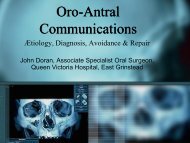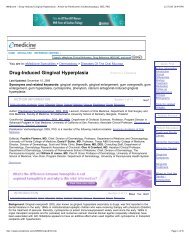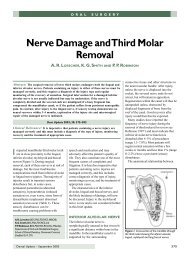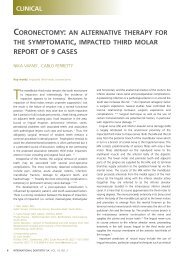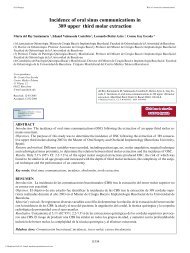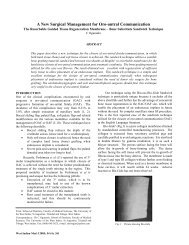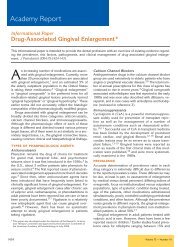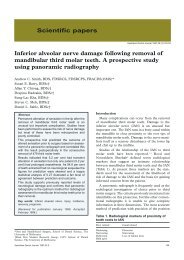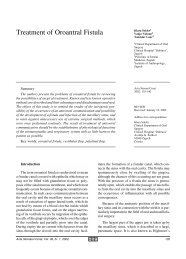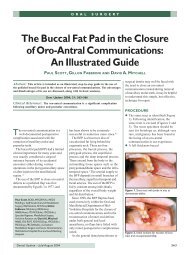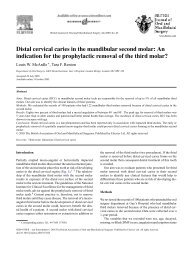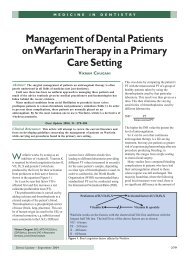management of the dental patient on warfarin - Surgical-Dentistry.Info
management of the dental patient on warfarin - Surgical-Dentistry.Info
management of the dental patient on warfarin - Surgical-Dentistry.Info
You also want an ePaper? Increase the reach of your titles
YUMPU automatically turns print PDFs into web optimized ePapers that Google loves.
SURGICAL MANAGEMENT OF THE PRIMARY<br />
CARE DENTAL PATIENT ON WARFARIN<br />
Warfarin does not need to be stopped before primary care <str<strong>on</strong>g>dental</str<strong>on</strong>g> surgical<br />
procedures<br />
C<strong>on</strong>tents<br />
Are <str<strong>on</strong>g>patient</str<strong>on</strong>g>s at risk <str<strong>on</strong>g>of</str<strong>on</strong>g> thromboembolic events if <strong>warfarin</strong> is stopped 2<br />
Are <str<strong>on</strong>g>patient</str<strong>on</strong>g>s at increased risk <str<strong>on</strong>g>of</str<strong>on</strong>g> bleeding if <strong>warfarin</strong> c<strong>on</strong>tinues 3<br />
Page<br />
If <strong>warfarin</strong> is c<strong>on</strong>tinued what is <str<strong>on</strong>g>the</str<strong>on</strong>g> incidence <str<strong>on</strong>g>of</str<strong>on</strong>g> postoperative bleeding and is it clinically<br />
significant<br />
3<br />
How do <str<strong>on</strong>g>the</str<strong>on</strong>g> risks <str<strong>on</strong>g>of</str<strong>on</strong>g> thromboembolic events and postoperative bleeding balance 4<br />
Which <str<strong>on</strong>g>patient</str<strong>on</strong>g>s taking <strong>warfarin</strong> should not undergo surgical procedures in primary care 6<br />
What is <str<strong>on</strong>g>the</str<strong>on</strong>g> normal INR range 6<br />
Up to what INR value can <str<strong>on</strong>g>dental</str<strong>on</strong>g> procedures be carried out in primary care 6<br />
When should <str<strong>on</strong>g>the</str<strong>on</strong>g> INR be measured before a <str<strong>on</strong>g>dental</str<strong>on</strong>g> procedure 7<br />
Should <str<strong>on</strong>g>the</str<strong>on</strong>g> primary care dentist ever advise an alterati<strong>on</strong> to <str<strong>on</strong>g>the</str<strong>on</strong>g> <strong>warfarin</strong> regimen 7<br />
For what procedures can <strong>warfarin</strong> be c<strong>on</strong>tinued safely 7<br />
How should <str<strong>on</strong>g>the</str<strong>on</strong>g> risk <str<strong>on</strong>g>of</str<strong>on</strong>g> bleeding be managed 7<br />
How should postoperative pain c<strong>on</strong>trol be managed 8<br />
Are <str<strong>on</strong>g>the</str<strong>on</strong>g>re any drug interacti<strong>on</strong>s that are relevant to this <str<strong>on</strong>g>patient</str<strong>on</strong>g> group 9<br />
Tranexamic acid mouthwash should not be used routinely in primary <str<strong>on</strong>g>dental</str<strong>on</strong>g><br />
care<br />
C<strong>on</strong>tents<br />
What is tranexamic acid 10<br />
What is <str<strong>on</strong>g>the</str<strong>on</strong>g> evidence <str<strong>on</strong>g>of</str<strong>on</strong>g> benefit for tranexamic acid mouthwash 10<br />
What are <str<strong>on</strong>g>the</str<strong>on</strong>g> practical issues associated with <str<strong>on</strong>g>the</str<strong>on</strong>g> use <str<strong>on</strong>g>of</str<strong>on</strong>g> tranexamic acid in primary care 11<br />
Management algorithm 12<br />
Appendix 1: Will I be paid if I use a haemostatic dressing and sutures 14<br />
Appendix 2: Will I be at risk from litigati<strong>on</strong> if <str<strong>on</strong>g>the</str<strong>on</strong>g> <str<strong>on</strong>g>patient</str<strong>on</strong>g> bleeds 14<br />
References 15<br />
Date <str<strong>on</strong>g>of</str<strong>on</strong>g> original preparati<strong>on</strong>: July 2001<br />
Date <str<strong>on</strong>g>of</str<strong>on</strong>g> first revisi<strong>on</strong>: March 2004<br />
Date <str<strong>on</strong>g>of</str<strong>on</strong>g> next revisi<strong>on</strong>: March 2006<br />
North West Medicines <strong>Info</strong>rmati<strong>on</strong> Centre<br />
Pharmacy Practice Unit, 70, Pembroke Place<br />
Liverpool, L69 3GF<br />
Editor: Christine Randall<br />
Tel: 0151 794 8206 Fax: 0151 794 8118 E-mail: druginfo@liv.ac.uk<br />
Date first published: July 2001 Date <str<strong>on</strong>g>of</str<strong>on</strong>g> revisi<strong>on</strong>: March 2004
SURGICAL MANAGEMENT OF THE PRIMARY<br />
CARE DENTAL PATIENT ON WARFARIN<br />
Executive summary<br />
Warfarin does not need to be stopped before<br />
primary care <str<strong>on</strong>g>dental</str<strong>on</strong>g> surgical procedures<br />
• Patients requiring <str<strong>on</strong>g>dental</str<strong>on</strong>g> surgical procedures in primary care and who have an<br />
Internati<strong>on</strong>al Normalised Ratio (INR) below 4.0 should c<strong>on</strong>tinue <strong>warfarin</strong> <str<strong>on</strong>g>the</str<strong>on</strong>g>rapy<br />
without dose adjustment.<br />
• Patients <strong>on</strong> <strong>warfarin</strong> might bleed more than normal but bleeding is easily treated with<br />
local measures.<br />
• The risk <str<strong>on</strong>g>of</str<strong>on</strong>g> thromboembolism after withdrawal <str<strong>on</strong>g>of</str<strong>on</strong>g> <strong>warfarin</strong> <str<strong>on</strong>g>the</str<strong>on</strong>g>rapy outweighs <str<strong>on</strong>g>the</str<strong>on</strong>g> risk<br />
<str<strong>on</strong>g>of</str<strong>on</strong>g> oral bleeding.<br />
Are <str<strong>on</strong>g>patient</str<strong>on</strong>g>s at risk <str<strong>on</strong>g>of</str<strong>on</strong>g> thromboembolic events if <strong>warfarin</strong> is stopped<br />
SUMMARY OF EVIDENCE<br />
• Stopping <strong>warfarin</strong> for two days increases <str<strong>on</strong>g>the</str<strong>on</strong>g> risk <str<strong>on</strong>g>of</str<strong>on</strong>g> thromboembolic events<br />
• This risk is difficult to estimate but is probably between 0.02% and 1%<br />
It has been comm<strong>on</strong> in primary care <str<strong>on</strong>g>dental</str<strong>on</strong>g> practice to disc<strong>on</strong>tinue <strong>warfarin</strong> treatment for a few<br />
days prior to <str<strong>on</strong>g>dental</str<strong>on</strong>g> surgery in order to limit bleeding problems. It has been assumed that stopping<br />
<strong>warfarin</strong> for a short period presents a negligible risk to <str<strong>on</strong>g>the</str<strong>on</strong>g> <str<strong>on</strong>g>patient</str<strong>on</strong>g>. However, data from trials and<br />
published case reports do not support this c<strong>on</strong>clusi<strong>on</strong>.<br />
Wahl reviewed 1 542 documented cases involving 493 <str<strong>on</strong>g>patient</str<strong>on</strong>g>s in whom anticoagulati<strong>on</strong> was<br />
withdrawn prior to a variety <str<strong>on</strong>g>of</str<strong>on</strong>g> <str<strong>on</strong>g>dental</str<strong>on</strong>g> procedures. He reported that:<br />
• 4 <str<strong>on</strong>g>patient</str<strong>on</strong>g>s experienced fatal thromboembolic events (2 cerebral thromboses, 1 myocardial<br />
infarcti<strong>on</strong>, 1 embolus - type not specified).<br />
• 1 <str<strong>on</strong>g>patient</str<strong>on</strong>g> experienced two n<strong>on</strong>-fatal thromboembolic complicati<strong>on</strong>s (1 cerebral embolus, 1<br />
brachial artery embolus).<br />
• <str<strong>on</strong>g>the</str<strong>on</strong>g> majority <str<strong>on</strong>g>of</str<strong>on</strong>g> <str<strong>on</strong>g>patient</str<strong>on</strong>g>s had no adverse effects.<br />
This gives an incidence <str<strong>on</strong>g>of</str<strong>on</strong>g> serious thromboembolic complicati<strong>on</strong>s <str<strong>on</strong>g>of</str<strong>on</strong>g> 1%. There has been criticism<br />
<str<strong>on</strong>g>of</str<strong>on</strong>g> this finding as <str<strong>on</strong>g>the</str<strong>on</strong>g> length <str<strong>on</strong>g>of</str<strong>on</strong>g> time that <str<strong>on</strong>g>the</str<strong>on</strong>g> anticoagulant was stopped was ei<str<strong>on</strong>g>the</str<strong>on</strong>g>r l<strong>on</strong>ger than<br />
normal practice (range 5-19 days) or unknown. 2 In additi<strong>on</strong>, although <str<strong>on</strong>g>the</str<strong>on</strong>g> data suggest that<br />
stopping anticoagulant <str<strong>on</strong>g>the</str<strong>on</strong>g>rapy caused <str<strong>on</strong>g>the</str<strong>on</strong>g> thromboembolic events, this cannot be assumed.<br />
The risk <str<strong>on</strong>g>of</str<strong>on</strong>g> thromboembolic events associated with <str<strong>on</strong>g>the</str<strong>on</strong>g> perioperative withdrawal <str<strong>on</strong>g>of</str<strong>on</strong>g> oral<br />
anticoagulants is also relevant to n<strong>on</strong>-<str<strong>on</strong>g>dental</str<strong>on</strong>g> procedures. One survey am<strong>on</strong>g American<br />
dermatologists calculated that following withdrawal <str<strong>on</strong>g>of</str<strong>on</strong>g> <strong>warfarin</strong> for between two and seven days,<br />
<strong>on</strong>e thromboembolic event occurred for every 6219 cutaneous excisi<strong>on</strong>s (0.02%) c<strong>on</strong>ducted. 3<br />
A small prospective n<strong>on</strong>-randomised study involving 40 <str<strong>on</strong>g>patient</str<strong>on</strong>g>s undergoing 50 vascular or general<br />
surgical operati<strong>on</strong>s was undertaken to determine <str<strong>on</strong>g>the</str<strong>on</strong>g> risk <str<strong>on</strong>g>of</str<strong>on</strong>g> operating <strong>on</strong> <str<strong>on</strong>g>patient</str<strong>on</strong>g>s taking <strong>warfarin</strong><br />
compared to <str<strong>on</strong>g>the</str<strong>on</strong>g> risk in <str<strong>on</strong>g>patient</str<strong>on</strong>g>s initially <strong>on</strong>, or c<strong>on</strong>verted to, heparin. 4 There were no<br />
thromboembolic events in <str<strong>on</strong>g>the</str<strong>on</strong>g> 30 <str<strong>on</strong>g>patient</str<strong>on</strong>g>s maintained <strong>on</strong> <strong>warfarin</strong>. However, five thromboembolic<br />
events (three clotted grafts, <strong>on</strong>e stroke and <strong>on</strong>e brachial artery embolism) occurred in <str<strong>on</strong>g>the</str<strong>on</strong>g> 15<br />
<str<strong>on</strong>g>patient</str<strong>on</strong>g>s in whom <strong>warfarin</strong> had been stopped, an incidence <str<strong>on</strong>g>of</str<strong>on</strong>g> 33%. Four <str<strong>on</strong>g>of</str<strong>on</strong>g> <str<strong>on</strong>g>the</str<strong>on</strong>g>se events were in<br />
<str<strong>on</strong>g>patient</str<strong>on</strong>g>s who were not started <strong>on</strong> heparin because <str<strong>on</strong>g>the</str<strong>on</strong>g>ir risk <str<strong>on</strong>g>of</str<strong>on</strong>g> thromboembolism was c<strong>on</strong>sidered<br />
to be low, i.e. <str<strong>on</strong>g>the</str<strong>on</strong>g> same assumpti<strong>on</strong> <str<strong>on</strong>g>of</str<strong>on</strong>g>ten made in primary <str<strong>on</strong>g>dental</str<strong>on</strong>g> practice. 4<br />
North West Medicines <strong>Info</strong>rmati<strong>on</strong> Centre 2 March 2004
A study looking at <str<strong>on</strong>g>the</str<strong>on</strong>g> risk <str<strong>on</strong>g>of</str<strong>on</strong>g> stroke in anticoagulated <str<strong>on</strong>g>patient</str<strong>on</strong>g>s with atrial fibrillati<strong>on</strong> undergoing<br />
endoscopy found that <str<strong>on</strong>g>of</str<strong>on</strong>g> 987 <str<strong>on</strong>g>patient</str<strong>on</strong>g>s (1137 procedures) in whom <str<strong>on</strong>g>the</str<strong>on</strong>g> anticoagulant was adjusted,<br />
12 <str<strong>on</strong>g>patient</str<strong>on</strong>g>s suffered a stroke within 30 days <str<strong>on</strong>g>of</str<strong>on</strong>g> <str<strong>on</strong>g>the</str<strong>on</strong>g> procedure, 9 <str<strong>on</strong>g>of</str<strong>on</strong>g> <str<strong>on</strong>g>the</str<strong>on</strong>g>se were within 7 days <str<strong>on</strong>g>of</str<strong>on</strong>g> <str<strong>on</strong>g>the</str<strong>on</strong>g><br />
procedure. In 438 <str<strong>on</strong>g>patient</str<strong>on</strong>g>s (457 procedures) in whom <str<strong>on</strong>g>the</str<strong>on</strong>g> anticoagulant was not adjusted n<strong>on</strong>e<br />
suffered a stroke. The authors calculated <str<strong>on</strong>g>the</str<strong>on</strong>g> risk <str<strong>on</strong>g>of</str<strong>on</strong>g> stroke as 0.79% in <str<strong>on</strong>g>the</str<strong>on</strong>g> 7 days after <str<strong>on</strong>g>the</str<strong>on</strong>g><br />
procedure and 1.06% in <str<strong>on</strong>g>the</str<strong>on</strong>g> 30 days after <str<strong>on</strong>g>the</str<strong>on</strong>g> procedure. Patients with more complex procedures<br />
and those with co-morbid illnesses were at an increased risk. 5<br />
N<strong>on</strong>e <str<strong>on</strong>g>of</str<strong>on</strong>g> <str<strong>on</strong>g>the</str<strong>on</strong>g> above trials give an estimate <str<strong>on</strong>g>of</str<strong>on</strong>g> <str<strong>on</strong>g>the</str<strong>on</strong>g> excess risk <str<strong>on</strong>g>of</str<strong>on</strong>g> thromboembolism associated with<br />
withdrawal <str<strong>on</strong>g>of</str<strong>on</strong>g> oral anticoagulant <str<strong>on</strong>g>the</str<strong>on</strong>g>rapy. This informati<strong>on</strong> can be estimated from a systematic<br />
review <str<strong>on</strong>g>of</str<strong>on</strong>g> peri-operative <str<strong>on</strong>g>management</str<strong>on</strong>g> <str<strong>on</strong>g>of</str<strong>on</strong>g> <str<strong>on</strong>g>patient</str<strong>on</strong>g>s <strong>on</strong> l<strong>on</strong>g-term anticoagulant <str<strong>on</strong>g>the</str<strong>on</strong>g>rapy that analysed<br />
data from 31 trials involving 1868 <str<strong>on</strong>g>patient</str<strong>on</strong>g>s. Thromboembolic events occurred in 1 <str<strong>on</strong>g>of</str<strong>on</strong>g> 237 (0.4%)<br />
<str<strong>on</strong>g>patient</str<strong>on</strong>g>s who c<strong>on</strong>tinued <str<strong>on</strong>g>the</str<strong>on</strong>g>ir oral anticoagulant, 6 <str<strong>on</strong>g>of</str<strong>on</strong>g> 996 (0.6%) <str<strong>on</strong>g>patient</str<strong>on</strong>g>s who stopped <str<strong>on</strong>g>the</str<strong>on</strong>g>ir oral<br />
anticoagulant and 1 <str<strong>on</strong>g>of</str<strong>on</strong>g> 372 (0.3%) <str<strong>on</strong>g>patient</str<strong>on</strong>g>s who stopped <str<strong>on</strong>g>the</str<strong>on</strong>g>ir oral anticoagulant and were given<br />
peri-operative heparin/low molecular weight heparin. The <str<strong>on</strong>g>management</str<strong>on</strong>g> strategy was unspecified<br />
or unclear for 263 <str<strong>on</strong>g>patient</str<strong>on</strong>g>s. 6 This suggests that <str<strong>on</strong>g>the</str<strong>on</strong>g> incidence <str<strong>on</strong>g>of</str<strong>on</strong>g> thromboembolic events is<br />
increased by 0.2% in <str<strong>on</strong>g>patient</str<strong>on</strong>g>s in whom oral anticoagulati<strong>on</strong> is stopped before a surgical procedure.<br />
Dods<strong>on</strong> also attempted to estimate excess risk associated with withdrawal <str<strong>on</strong>g>of</str<strong>on</strong>g> oral anticoagulants<br />
for a short period. He calculated <str<strong>on</strong>g>the</str<strong>on</strong>g> difference in <str<strong>on</strong>g>the</str<strong>on</strong>g> incidence <str<strong>on</strong>g>of</str<strong>on</strong>g> stroke over <strong>on</strong>e year between<br />
<str<strong>on</strong>g>patient</str<strong>on</strong>g>s with atrial fibrillati<strong>on</strong> <strong>on</strong> <strong>warfarin</strong> (1.4%) and those who disc<strong>on</strong>tinued <strong>warfarin</strong> (5.0%), and<br />
divided this difference by 2/365 (for 2 days). On this basis, he calculated that <str<strong>on</strong>g>the</str<strong>on</strong>g> excess risk <str<strong>on</strong>g>of</str<strong>on</strong>g><br />
stroke in <str<strong>on</strong>g>patient</str<strong>on</strong>g>s with atrial fibrillati<strong>on</strong> who disc<strong>on</strong>tinue <strong>warfarin</strong> for 2 days to be 1 in 5069 (0.02%).<br />
A similar calculati<strong>on</strong> suggests that in <str<strong>on</strong>g>patient</str<strong>on</strong>g>s taking <strong>warfarin</strong> for pros<str<strong>on</strong>g>the</str<strong>on</strong>g>tic valve replacement, <str<strong>on</strong>g>the</str<strong>on</strong>g><br />
figure is 1 in 6083 cases (0.02%). 7<br />
The estimated risk <str<strong>on</strong>g>of</str<strong>on</strong>g> thromboembolic events if <strong>warfarin</strong> is disc<strong>on</strong>tinued prior to surgical<br />
procedures <str<strong>on</strong>g>the</str<strong>on</strong>g>refore varies c<strong>on</strong>siderably between studies. For minor procedures such as <str<strong>on</strong>g>dental</str<strong>on</strong>g><br />
surgery, <str<strong>on</strong>g>the</str<strong>on</strong>g> risk appears to vary from 0.02% to 1%.<br />
Hypercoagulable state<br />
It has been suggested that stopping <strong>warfarin</strong> <str<strong>on</strong>g>the</str<strong>on</strong>g>rapy can lead to a rebound hypercoagulable<br />
state. 1,6,8,9,10,11 Biochemical evidence indicates that an immediate increase in clotting factors and<br />
thrombin activity occurs after withdrawal <str<strong>on</strong>g>of</str<strong>on</strong>g> <strong>warfarin</strong>. However, <str<strong>on</strong>g>the</str<strong>on</strong>g> clinical significance <str<strong>on</strong>g>of</str<strong>on</strong>g> this is<br />
unclear as a hypercoagulable state has yet to be dem<strong>on</strong>strated by clinical studies.<br />
Are <str<strong>on</strong>g>patient</str<strong>on</strong>g>s at increased risk <str<strong>on</strong>g>of</str<strong>on</strong>g> bleeding if <strong>warfarin</strong> c<strong>on</strong>tinues<br />
Yes. Treatment with <strong>warfarin</strong> impairs clotting and c<strong>on</strong>sequently <str<strong>on</strong>g>patient</str<strong>on</strong>g>s have an increased risk <str<strong>on</strong>g>of</str<strong>on</strong>g><br />
bleeding during surgical procedures and post-operatively. Bleeding in <str<strong>on</strong>g>the</str<strong>on</strong>g> mouth can be excessive,<br />
even in n<strong>on</strong>-anticoagulated <str<strong>on</strong>g>patient</str<strong>on</strong>g>s. This is because <str<strong>on</strong>g>the</str<strong>on</strong>g> tooth support structures are highly<br />
vascular and, in additi<strong>on</strong>, saliva c<strong>on</strong>tains c<strong>on</strong>stituents with a fibrinolytic acti<strong>on</strong>.<br />
If <strong>warfarin</strong> is c<strong>on</strong>tinued what is <str<strong>on</strong>g>the</str<strong>on</strong>g> incidence <str<strong>on</strong>g>of</str<strong>on</strong>g> postoperative bleeding and<br />
is it clinically significant<br />
SUMMARY OF EVIDENCE<br />
• C<strong>on</strong>tinuing <strong>warfarin</strong> during <str<strong>on</strong>g>dental</str<strong>on</strong>g> surgical procedures will increase <str<strong>on</strong>g>the</str<strong>on</strong>g> risk <str<strong>on</strong>g>of</str<strong>on</strong>g> postoperative<br />
bleeding requiring interventi<strong>on</strong>.<br />
• Stopping <strong>warfarin</strong> is no guarantee that <str<strong>on</strong>g>the</str<strong>on</strong>g> risk <str<strong>on</strong>g>of</str<strong>on</strong>g> postoperative bleeding requiring interventi<strong>on</strong><br />
will be eliminated as serious bleeding can occur in n<strong>on</strong>-anticoagulated <str<strong>on</strong>g>patient</str<strong>on</strong>g>s.<br />
• Most cases <str<strong>on</strong>g>of</str<strong>on</strong>g> postoperative bleeding can be managed by pressure or repacking and<br />
resuturing <str<strong>on</strong>g>the</str<strong>on</strong>g> socket.<br />
• The incidence <str<strong>on</strong>g>of</str<strong>on</strong>g> postoperative bleeding not c<strong>on</strong>trolled by local measures varies from 0% to<br />
3.5%.<br />
Clinically significant postoperative bleeding has been defined 12 as that which;<br />
1. C<strong>on</strong>tinues bey<strong>on</strong>d 12 hours, or<br />
2. Causes <str<strong>on</strong>g>the</str<strong>on</strong>g> <str<strong>on</strong>g>patient</str<strong>on</strong>g> to call or return to <str<strong>on</strong>g>the</str<strong>on</strong>g> <str<strong>on</strong>g>dental</str<strong>on</strong>g> practice or accident and emergency<br />
department, or<br />
North West Medicines <strong>Info</strong>rmati<strong>on</strong> Centre 3 March 2004
3. Results in <str<strong>on</strong>g>the</str<strong>on</strong>g> development <str<strong>on</strong>g>of</str<strong>on</strong>g> a large haematoma or ecchymosis within <str<strong>on</strong>g>the</str<strong>on</strong>g> oral s<str<strong>on</strong>g>of</str<strong>on</strong>g>t tissues,<br />
or<br />
4. Requires a blood transfusi<strong>on</strong>.<br />
Volume <str<strong>on</strong>g>of</str<strong>on</strong>g> blood<br />
Few studies have investigated <str<strong>on</strong>g>the</str<strong>on</strong>g> volume <str<strong>on</strong>g>of</str<strong>on</strong>g> blood lost during <str<strong>on</strong>g>dental</str<strong>on</strong>g> surgical procedures, but<br />
those that have report losses varying from 9.7ml per tooth in anticoagulated <str<strong>on</strong>g>patient</str<strong>on</strong>g>s to an average<br />
<str<strong>on</strong>g>of</str<strong>on</strong>g> 223ml per sessi<strong>on</strong> in <str<strong>on</strong>g>patient</str<strong>on</strong>g>s not taking anticoagulants. 9 A small study found no difference in<br />
<str<strong>on</strong>g>the</str<strong>on</strong>g> blood loss between <str<strong>on</strong>g>patient</str<strong>on</strong>g>s who c<strong>on</strong>tinued <strong>warfarin</strong> and those who stopped it 72 to 96 hours<br />
before <str<strong>on</strong>g>the</str<strong>on</strong>g> procedure. 10<br />
Postoperative bleeding risk<br />
Wahl estimated <str<strong>on</strong>g>the</str<strong>on</strong>g> incidence <str<strong>on</strong>g>of</str<strong>on</strong>g> serious bleeding problems in 950 <str<strong>on</strong>g>patient</str<strong>on</strong>g>s receiving<br />
anticoagulati<strong>on</strong> undergoing 2400 individual <str<strong>on</strong>g>dental</str<strong>on</strong>g> procedures. 13 Only 12 <str<strong>on</strong>g>patient</str<strong>on</strong>g>s (
Table 1 Haemostatic <str<strong>on</strong>g>management</str<strong>on</strong>g> and postoperative bleeding incidence in <str<strong>on</strong>g>dental</str<strong>on</strong>g> surgical <str<strong>on</strong>g>patient</str<strong>on</strong>g>s<br />
when oral anticoagulati<strong>on</strong> was c<strong>on</strong>tinued<br />
Trial<br />
Souto et<br />
al. 15 ‡<br />
(RCT)<br />
Devani et<br />
al. 11‡<br />
(RCT)<br />
Campbell et<br />
al. 10<br />
(CT)<br />
Blinder et<br />
al. 16‡<br />
(CT)<br />
Blinder et<br />
al. 17<br />
(case<br />
series)<br />
Halfpenny<br />
et al. 18<br />
(RCT)<br />
Evans<br />
etal. 19<br />
(RCT)<br />
Barrero et<br />
al. 20<br />
(case<br />
series)<br />
Alexander<br />
et al. 21<br />
(pers<strong>on</strong>al<br />
experience)<br />
Zan<strong>on</strong> et<br />
al. 14<br />
(case<br />
c<strong>on</strong>trol<br />
series)<br />
No.<br />
pts*<br />
Anticoagulant<br />
INR<br />
range**<br />
(protocol<br />
INR<br />
range)<br />
53 Acenocoumarol 1.5 – 5.2<br />
(2 – 4)<br />
33 Warfarin 2.2 – 3.9<br />
(2 – 4)<br />
Mean<br />
INR<br />
Haemostatic<br />
dressing used<br />
(number <str<strong>on</strong>g>of</str<strong>on</strong>g><br />
<str<strong>on</strong>g>patient</str<strong>on</strong>g>s)<br />
3.1 N<strong>on</strong>e, antifibrinolytic<br />
mouthwash<br />
2.7 Oxidised cellulose<br />
Surgicel (all)<br />
Suture<br />
12 Warfarin 1.2 - 2.9 2.0 N<strong>on</strong>e N<strong>on</strong>e 0 (0)<br />
150 ‘Coumarin’ 1.5 – 4.0<br />
(1.5 – 4)<br />
249 ‘Coumarin’ 1.5 - >3.5<br />
(1.5 -<br />
>3.5)<br />
46 Warfarin 2 – 4.1<br />
(2 – 4.5)<br />
57 Warfarin 1.2 – 4.7<br />
(5<br />
mins (1)<br />
0 (0)<br />
Silk 4 (4) Gelatin sp<strong>on</strong>ge pack and<br />
suturing<br />
Total no.<br />
<str<strong>on</strong>g>patient</str<strong>on</strong>g>s = 990 89 (9.0%) delayed postoperative<br />
bleeds (35 (3.5%) serious***)<br />
* This column indicates <str<strong>on</strong>g>the</str<strong>on</strong>g> number <str<strong>on</strong>g>of</str<strong>on</strong>g> <str<strong>on</strong>g>patient</str<strong>on</strong>g>s for whom oral anticoagulati<strong>on</strong> was c<strong>on</strong>tinued, some trials also included a<br />
group <str<strong>on</strong>g>of</str<strong>on</strong>g> <str<strong>on</strong>g>patient</str<strong>on</strong>g>s for whom oral anticoagulati<strong>on</strong> was stopped or a group <str<strong>on</strong>g>of</str<strong>on</strong>g> <str<strong>on</strong>g>patient</str<strong>on</strong>g>s not taking an oral anticoagulant.<br />
** Measured range for study participants<br />
*** Serious = requiring repacking and resuturing<br />
**** epinephrine = adrenaline<br />
‡<br />
= Studies included in Wahl’s review 13<br />
RCT = randomised c<strong>on</strong>trolled trial<br />
CT = c<strong>on</strong>trolled trial<br />
North West Medicines <strong>Info</strong>rmati<strong>on</strong> Centre 5 March 2004
In compiling this review no cases <str<strong>on</strong>g>of</str<strong>on</strong>g> permanent disability or death, reported as a c<strong>on</strong>sequence <str<strong>on</strong>g>of</str<strong>on</strong>g><br />
postoperative bleeding associated with a <str<strong>on</strong>g>dental</str<strong>on</strong>g> surgical procedure in which <str<strong>on</strong>g>the</str<strong>on</strong>g> <str<strong>on</strong>g>patient</str<strong>on</strong>g> c<strong>on</strong>tinued<br />
oral anticoagulati<strong>on</strong>, were found.<br />
The majority <str<strong>on</strong>g>of</str<strong>on</strong>g> publicati<strong>on</strong>s that have c<strong>on</strong>sidered <str<strong>on</strong>g>the</str<strong>on</strong>g> risks <str<strong>on</strong>g>of</str<strong>on</strong>g> stopping versus c<strong>on</strong>tinuing oral<br />
anticoagulati<strong>on</strong> for <str<strong>on</strong>g>dental</str<strong>on</strong>g> procedures have c<strong>on</strong>cluded that most <str<strong>on</strong>g>dental</str<strong>on</strong>g> <str<strong>on</strong>g>patient</str<strong>on</strong>g>s can undergo<br />
procedures without alterati<strong>on</strong> to <str<strong>on</strong>g>the</str<strong>on</strong>g>ir oral anticoagulant provided that local haemostatic measures<br />
are used to c<strong>on</strong>trol bleeding. 1,6-8,10-14,16-22<br />
Which <str<strong>on</strong>g>patient</str<strong>on</strong>g>s taking <strong>warfarin</strong> should not undergo surgical procedures in<br />
primary care<br />
Patients who have an INR greater than 4.0 should not undergo any form <str<strong>on</strong>g>of</str<strong>on</strong>g> surgical procedure<br />
without c<strong>on</strong>sultati<strong>on</strong> with <str<strong>on</strong>g>the</str<strong>on</strong>g> clinician who is resp<strong>on</strong>sible for maintaining <str<strong>on</strong>g>the</str<strong>on</strong>g>ir anticoagulati<strong>on</strong> (this<br />
may be <str<strong>on</strong>g>the</str<strong>on</strong>g> GP or <str<strong>on</strong>g>the</str<strong>on</strong>g> hospital anticoagulant clinic haematologist). The <strong>warfarin</strong> dose will need to<br />
be adjusted prior to <str<strong>on</strong>g>the</str<strong>on</strong>g> procedure. Patients who are maintained with an INR >4.0 or who have<br />
very erratic c<strong>on</strong>trol may need to be referred to a <str<strong>on</strong>g>dental</str<strong>on</strong>g> hospital or hospital based oral/maxill<str<strong>on</strong>g>of</str<strong>on</strong>g>acial<br />
surge<strong>on</strong>.<br />
The following medical problems may affect coagulati<strong>on</strong> and clotting: 11,22,23,24<br />
• liver impairment and/or alcoholism<br />
• renal failure<br />
• thrombocytopenia, haemophilia or o<str<strong>on</strong>g>the</str<strong>on</strong>g>r disorder <str<strong>on</strong>g>of</str<strong>on</strong>g> haemostasis<br />
• those currently receiving a course <str<strong>on</strong>g>of</str<strong>on</strong>g> cytotoxic medicati<strong>on</strong>.<br />
Patients with any <str<strong>on</strong>g>of</str<strong>on</strong>g> <str<strong>on</strong>g>the</str<strong>on</strong>g>se c<strong>on</strong>diti<strong>on</strong>s who also take <strong>warfarin</strong> should not be treated in primary care<br />
but referred to a <str<strong>on</strong>g>dental</str<strong>on</strong>g> hospital or hospital based <str<strong>on</strong>g>dental</str<strong>on</strong>g> clinic.<br />
Patients requiring major surgery are unlikely to be treated in <str<strong>on</strong>g>the</str<strong>on</strong>g> primary care setting.<br />
What is <str<strong>on</strong>g>the</str<strong>on</strong>g> normal INR range<br />
The activity <str<strong>on</strong>g>of</str<strong>on</strong>g> <strong>warfarin</strong> is expressed using <str<strong>on</strong>g>the</str<strong>on</strong>g> internati<strong>on</strong>al normalised ratio (INR). For an<br />
individual not taking <strong>warfarin</strong> a normal coagulati<strong>on</strong> pr<str<strong>on</strong>g>of</str<strong>on</strong>g>ile is an INR <str<strong>on</strong>g>of</str<strong>on</strong>g> 1.0.<br />
UK guidelines 25 recommend <str<strong>on</strong>g>the</str<strong>on</strong>g> following target INRs:<br />
Indicati<strong>on</strong> UK INR target Acceptable range<br />
Pulm<strong>on</strong>ary embolus (PE) 2.5 2.0-3.0<br />
Deep vein thrombosis (DVT) 2.5 2.0-3.0<br />
Atrial fibrillati<strong>on</strong> 2.5 2.0-3.0<br />
Recurrence <str<strong>on</strong>g>of</str<strong>on</strong>g> embolism - no l<strong>on</strong>ger <strong>on</strong> <strong>warfarin</strong> 2.5 2.0-3.0<br />
Recurrence <str<strong>on</strong>g>of</str<strong>on</strong>g> embolism <strong>on</strong> <strong>warfarin</strong> 3.5 3.0-4.0<br />
Mechanical pros<str<strong>on</strong>g>the</str<strong>on</strong>g>tic heart valves 3.5 3.0-4.0<br />
Antiphospholipid syndrome 3.5 3.0-4.0<br />
In <str<strong>on</strong>g>the</str<strong>on</strong>g>ory all <str<strong>on</strong>g>patient</str<strong>on</strong>g>s will have an INR below 4.0.<br />
Up to what INR value can <str<strong>on</strong>g>dental</str<strong>on</strong>g> procedures be carried out in primary care<br />
SUMMARY OF EVIDENCE<br />
• Published trial data suggests that minor <str<strong>on</strong>g>dental</str<strong>on</strong>g> surgical procedures can be safely carried out<br />
<strong>on</strong> <str<strong>on</strong>g>patient</str<strong>on</strong>g>s with an INR ≤4.0.<br />
• The c<strong>on</strong>sensus from reviews <strong>on</strong> <str<strong>on</strong>g>the</str<strong>on</strong>g> <str<strong>on</strong>g>management</str<strong>on</strong>g> <str<strong>on</strong>g>of</str<strong>on</strong>g> <str<strong>on</strong>g>dental</str<strong>on</strong>g> <str<strong>on</strong>g>patient</str<strong>on</strong>g>s taking <strong>warfarin</strong> is that<br />
minor <str<strong>on</strong>g>dental</str<strong>on</strong>g> surgical procedures should be carried out without alterati<strong>on</strong> to <str<strong>on</strong>g>the</str<strong>on</strong>g> <str<strong>on</strong>g>patient</str<strong>on</strong>g>’s<br />
<strong>warfarin</strong> <str<strong>on</strong>g>the</str<strong>on</strong>g>rapy if <str<strong>on</strong>g>the</str<strong>on</strong>g> INR is within <str<strong>on</strong>g>the</str<strong>on</strong>g> <str<strong>on</strong>g>the</str<strong>on</strong>g>rapeutic range (INR 2.0 – 4.0).<br />
• Dentists from general and community <str<strong>on</strong>g>dental</str<strong>on</strong>g> practice have reported no problems in carrying<br />
out minor <str<strong>on</strong>g>dental</str<strong>on</strong>g> surgical procedures <strong>on</strong> <str<strong>on</strong>g>patient</str<strong>on</strong>g>s with an INR within <str<strong>on</strong>g>the</str<strong>on</strong>g> <str<strong>on</strong>g>the</str<strong>on</strong>g>rapeutic range.<br />
North West Medicines <strong>Info</strong>rmati<strong>on</strong> Centre 6 March 2004
Of <str<strong>on</strong>g>the</str<strong>on</strong>g> 10 trials/case series listed in Table 1, <strong>on</strong>e stated that minor <str<strong>on</strong>g>dental</str<strong>on</strong>g> surgical procedures<br />
could be carried out with <str<strong>on</strong>g>the</str<strong>on</strong>g> INR ≤4.5, 18 six limited <str<strong>on</strong>g>the</str<strong>on</strong>g> INR to ≤4.0, 11,14-16,19,21 <strong>on</strong>e just stated ≥3.5<br />
(23 <str<strong>on</strong>g>patient</str<strong>on</strong>g>s included with INRs ≥3.5), 17 <strong>on</strong>e limited <str<strong>on</strong>g>the</str<strong>on</strong>g> INR to ≤3.0 20 and <strong>on</strong>e trial stated no limits<br />
but included <str<strong>on</strong>g>patient</str<strong>on</strong>g>s with INRs up to 3.0. 10 Results suggest that limiting <str<strong>on</strong>g>the</str<strong>on</strong>g> INR to ≤4.0 enables<br />
procedures to be carried out safely without excessive postoperative bleeding.<br />
Reviews discussing <str<strong>on</strong>g>the</str<strong>on</strong>g> c<strong>on</strong>tinuati<strong>on</strong> <str<strong>on</strong>g>of</str<strong>on</strong>g> oral anticoagulati<strong>on</strong> during minor <str<strong>on</strong>g>dental</str<strong>on</strong>g> surgical<br />
procedures have advocated that procedures can safely be carried out with <str<strong>on</strong>g>the</str<strong>on</strong>g> INR within <str<strong>on</strong>g>the</str<strong>on</strong>g><br />
<str<strong>on</strong>g>the</str<strong>on</strong>g>rapeutic range (2.0 – 4.0) when local haemostatic measures are used to c<strong>on</strong>trol bleeding. 1,6-<br />
8,13,26 O<str<strong>on</strong>g>the</str<strong>on</strong>g>rs have advocated upper limits <str<strong>on</strong>g>of</str<strong>on</strong>g> 3.5 22,27,28,29 or 3.0. 30<br />
A series <str<strong>on</strong>g>of</str<strong>on</strong>g> letters in <str<strong>on</strong>g>the</str<strong>on</strong>g> British Dental Journal in 2002/2003 31,32,33,34,35,36,37,38,39,40 highlight <str<strong>on</strong>g>the</str<strong>on</strong>g> lack<br />
<str<strong>on</strong>g>of</str<strong>on</strong>g> c<strong>on</strong>sensus, but a gradual change in practice, around <str<strong>on</strong>g>the</str<strong>on</strong>g> <str<strong>on</strong>g>management</str<strong>on</strong>g> <str<strong>on</strong>g>of</str<strong>on</strong>g> <str<strong>on</strong>g>dental</str<strong>on</strong>g> <str<strong>on</strong>g>patient</str<strong>on</strong>g>s who<br />
take <strong>warfarin</strong>. The series includes letters from practiti<strong>on</strong>ers in general <str<strong>on</strong>g>dental</str<strong>on</strong>g> practice 33 and<br />
community <str<strong>on</strong>g>dental</str<strong>on</strong>g> practice 34,36 reporting that <str<strong>on</strong>g>the</str<strong>on</strong>g>y routinely carry out <str<strong>on</strong>g>dental</str<strong>on</strong>g> procedures without any<br />
problems in <str<strong>on</strong>g>patient</str<strong>on</strong>g>s whose INR is within <str<strong>on</strong>g>the</str<strong>on</strong>g> <str<strong>on</strong>g>the</str<strong>on</strong>g>rapeutic range.<br />
When should <str<strong>on</strong>g>the</str<strong>on</strong>g> INR be measured before a <str<strong>on</strong>g>dental</str<strong>on</strong>g> procedure<br />
The INR must be measured prior to <str<strong>on</strong>g>dental</str<strong>on</strong>g> procedures, ideally this should be d<strong>on</strong>e within 24 hours<br />
before <str<strong>on</strong>g>the</str<strong>on</strong>g> procedure. 14,16,17,18,19,20,21,22,23,27,28 However, this is difficult to achieve in primary care<br />
<str<strong>on</strong>g>dental</str<strong>on</strong>g> practice. For <str<strong>on</strong>g>patient</str<strong>on</strong>g>s who have a stable INR, an INR measured within 72 hours before <str<strong>on</strong>g>the</str<strong>on</strong>g><br />
procedure is acceptable. Patients will need ei<str<strong>on</strong>g>the</str<strong>on</strong>g>r to co-ordinate <str<strong>on</strong>g>the</str<strong>on</strong>g>ir <str<strong>on</strong>g>dental</str<strong>on</strong>g> treatment with <str<strong>on</strong>g>the</str<strong>on</strong>g>ir<br />
next planned INR measurement or have an extra INR measurement within 72 hours <str<strong>on</strong>g>of</str<strong>on</strong>g> <str<strong>on</strong>g>the</str<strong>on</strong>g>ir<br />
planned <str<strong>on</strong>g>dental</str<strong>on</strong>g> treatment.<br />
N.B. The INR is valid <strong>on</strong>ly for <str<strong>on</strong>g>patient</str<strong>on</strong>g>s who have stable anticoagulant <str<strong>on</strong>g>the</str<strong>on</strong>g>rapy. Patients presenting<br />
with an INR much higher than <str<strong>on</strong>g>the</str<strong>on</strong>g>ir normal value, even if it is less than 4.0, should have <str<strong>on</strong>g>the</str<strong>on</strong>g>ir<br />
procedure postp<strong>on</strong>ed and should be referred back to <str<strong>on</strong>g>the</str<strong>on</strong>g> clinician maintaining <str<strong>on</strong>g>the</str<strong>on</strong>g>ir anticoagulant<br />
<str<strong>on</strong>g>the</str<strong>on</strong>g>rapy.<br />
Should <str<strong>on</strong>g>the</str<strong>on</strong>g> primary care dentist ever advise an alterati<strong>on</strong> to <str<strong>on</strong>g>the</str<strong>on</strong>g> <strong>warfarin</strong><br />
regimen<br />
No. The GP or <str<strong>on</strong>g>the</str<strong>on</strong>g> anticoagulant clinic must do this.<br />
For what procedures can <strong>warfarin</strong> be c<strong>on</strong>tinued safely<br />
Minor surgical procedures can be safely carried out without altering <str<strong>on</strong>g>the</str<strong>on</strong>g> <strong>warfarin</strong> dose. Those likely<br />
to be carried out in primary care will be classified as minor e.g. simple extracti<strong>on</strong> <str<strong>on</strong>g>of</str<strong>on</strong>g> up to 3 teeth,<br />
gingival surgery, crown and bridge procedures, <str<strong>on</strong>g>dental</str<strong>on</strong>g> scaling and <str<strong>on</strong>g>the</str<strong>on</strong>g> surgical removal <str<strong>on</strong>g>of</str<strong>on</strong>g><br />
teeth. 8,12,21,24<br />
When more than 3 teeth need to be extracted <str<strong>on</strong>g>the</str<strong>on</strong>g>n multiple visits will be required. The extracti<strong>on</strong>s<br />
may be planned to remove 2-3 teeth at a time, by quadrants, or singly at separate vists. 7,21,23<br />
Scaling and root planning should initially be restricted to a limited area to assess if <str<strong>on</strong>g>the</str<strong>on</strong>g> bleeding is<br />
problematic.<br />
How should <str<strong>on</strong>g>the</str<strong>on</strong>g> risk <str<strong>on</strong>g>of</str<strong>on</strong>g> bleeding be managed<br />
Timing<br />
Think about <str<strong>on</strong>g>the</str<strong>on</strong>g> timing <str<strong>on</strong>g>of</str<strong>on</strong>g> <str<strong>on</strong>g>the</str<strong>on</strong>g> surgery. Planned surgery should ideally be:<br />
• At <str<strong>on</strong>g>the</str<strong>on</strong>g> beginning <str<strong>on</strong>g>of</str<strong>on</strong>g> <str<strong>on</strong>g>the</str<strong>on</strong>g> day - this allows more time to deal with immediate re-bleeding<br />
problems.<br />
• Early in <str<strong>on</strong>g>the</str<strong>on</strong>g> week- this allows for delayed re-bleeding episodes occurring after 24–48 hours to<br />
be dealt with during <str<strong>on</strong>g>the</str<strong>on</strong>g> working week. A Tuesday morning procedure allows <str<strong>on</strong>g>the</str<strong>on</strong>g> <str<strong>on</strong>g>patient</str<strong>on</strong>g> to<br />
have <str<strong>on</strong>g>the</str<strong>on</strong>g>ir INR measured <strong>on</strong> M<strong>on</strong>day. 28<br />
North West Medicines <strong>Info</strong>rmati<strong>on</strong> Centre 7 March 2004
Local anaes<str<strong>on</strong>g>the</str<strong>on</strong>g>tic<br />
A local anaes<str<strong>on</strong>g>the</str<strong>on</strong>g>tic c<strong>on</strong>taining a vasoc<strong>on</strong>strictor should be administered by infiltrati<strong>on</strong> or by<br />
intraligamentary injecti<strong>on</strong> wherever practical. 12 Regi<strong>on</strong>al nerve blocks should be avoided when<br />
possible. However, if <str<strong>on</strong>g>the</str<strong>on</strong>g>re is no alternative, local anaes<str<strong>on</strong>g>the</str<strong>on</strong>g>tic should be administered cautiously<br />
using an aspirating syringe. 12,17,23,24,28 Local vasoc<strong>on</strong>stricti<strong>on</strong> may be encouraged by infiltrating a<br />
small amount <str<strong>on</strong>g>of</str<strong>on</strong>g> local anaes<str<strong>on</strong>g>the</str<strong>on</strong>g>tic c<strong>on</strong>taining adrenaline (epinephrine) close to <str<strong>on</strong>g>the</str<strong>on</strong>g> site <str<strong>on</strong>g>of</str<strong>on</strong>g><br />
surgery. 30<br />
Local haemostasis<br />
Sockets should be gently packed with an absorbable haemostatic dressing 8,12,23,24,28 e.g. oxidised<br />
cellulose (Surgicel ® ), collagen sp<strong>on</strong>ge (Haemocollagen ® ) or resorbable gelatin sp<strong>on</strong>ge<br />
(Sp<strong>on</strong>gostan ® ), <str<strong>on</strong>g>the</str<strong>on</strong>g>n carefully sutured. Trials in <str<strong>on</strong>g>patient</str<strong>on</strong>g>s who have c<strong>on</strong>tinued anticoagulant <str<strong>on</strong>g>the</str<strong>on</strong>g>rapy<br />
throughout <str<strong>on</strong>g>the</str<strong>on</strong>g> perioperative period have used resorbable (catgut or syn<str<strong>on</strong>g>the</str<strong>on</strong>g>tic – Vicryl polyglactin)<br />
or n<strong>on</strong>-resorbable (silk, polyamide, polypropylene) sutures. Resorbable sutures are preferable as<br />
<str<strong>on</strong>g>the</str<strong>on</strong>g>y attract less plaque. 28 If n<strong>on</strong>-resorbable sutures are used <str<strong>on</strong>g>the</str<strong>on</strong>g>y should be removed after 4-7<br />
days. 28 Following closure, pressure should be applied to <str<strong>on</strong>g>the</str<strong>on</strong>g> socket(s) by using a gauze pad that<br />
<str<strong>on</strong>g>the</str<strong>on</strong>g> <str<strong>on</strong>g>patient</str<strong>on</strong>g> bites down <strong>on</strong> for 20 minutes.<br />
Efforts should be made to make <str<strong>on</strong>g>the</str<strong>on</strong>g> procedure as atraumatic as possible and any bleeding should<br />
be managed using local measures.<br />
The use <str<strong>on</strong>g>of</str<strong>on</strong>g> tranexamic acid mouthwash, which acts as a local antifibrinolytic agent, has been<br />
investigated but is not recommended routinely in primary care (see page 10).<br />
Post operative <str<strong>on</strong>g>management</str<strong>on</strong>g><br />
Patients should be given clear instructi<strong>on</strong>s <strong>on</strong> <str<strong>on</strong>g>the</str<strong>on</strong>g> <str<strong>on</strong>g>management</str<strong>on</strong>g> <str<strong>on</strong>g>of</str<strong>on</strong>g> <str<strong>on</strong>g>the</str<strong>on</strong>g> clot in <str<strong>on</strong>g>the</str<strong>on</strong>g> postoperative<br />
period and advised: 41<br />
• to look after <str<strong>on</strong>g>the</str<strong>on</strong>g> initial clot by resting while <str<strong>on</strong>g>the</str<strong>on</strong>g> local anaes<str<strong>on</strong>g>the</str<strong>on</strong>g>tic wears <str<strong>on</strong>g>of</str<strong>on</strong>g>f and <str<strong>on</strong>g>the</str<strong>on</strong>g> clot fully<br />
forms (2-3 hours)<br />
• to avoid rinsing <str<strong>on</strong>g>the</str<strong>on</strong>g> mouth for 24 hours<br />
• not to suck hard or disturb <str<strong>on</strong>g>the</str<strong>on</strong>g> socket with <str<strong>on</strong>g>the</str<strong>on</strong>g> t<strong>on</strong>gue or any foreign object<br />
• to avoid hot liquids and hard foods for <str<strong>on</strong>g>the</str<strong>on</strong>g> rest <str<strong>on</strong>g>of</str<strong>on</strong>g> <str<strong>on</strong>g>the</str<strong>on</strong>g> day<br />
• to avoid chewing <strong>on</strong> <str<strong>on</strong>g>the</str<strong>on</strong>g> affected side until it is clear that a stable clot has formed. Care should<br />
<str<strong>on</strong>g>the</str<strong>on</strong>g>n be taken to avoid dislodging <str<strong>on</strong>g>the</str<strong>on</strong>g> clot<br />
• if bleeding c<strong>on</strong>tinues or restarts to apply pressure over <str<strong>on</strong>g>the</str<strong>on</strong>g> socket using a folded clean<br />
handkerchief or gauze pad. Place <str<strong>on</strong>g>the</str<strong>on</strong>g> pad over <str<strong>on</strong>g>the</str<strong>on</strong>g> socket and bite down firmly for 20 minutes.<br />
If bleeding does not stop, <str<strong>on</strong>g>the</str<strong>on</strong>g> dentist should be c<strong>on</strong>tacted; repacking and resuturing <str<strong>on</strong>g>of</str<strong>on</strong>g> <str<strong>on</strong>g>the</str<strong>on</strong>g><br />
socket may be required<br />
• who to c<strong>on</strong>tact if <str<strong>on</strong>g>the</str<strong>on</strong>g>y have excessive or prol<strong>on</strong>ged postoperative bleeding. The surgery and<br />
out <str<strong>on</strong>g>of</str<strong>on</strong>g> hours/<strong>on</strong> call dentist’s name/number should be provided. There should be a facility for<br />
<str<strong>on</strong>g>the</str<strong>on</strong>g> <str<strong>on</strong>g>patient</str<strong>on</strong>g> to be reviewed and treated immediately by a dentist if a bleeding problem occurs. If<br />
it is not possible for <str<strong>on</strong>g>the</str<strong>on</strong>g> <str<strong>on</strong>g>patient</str<strong>on</strong>g> to be seen immediately by a dentist <str<strong>on</strong>g>the</str<strong>on</strong>g>n <str<strong>on</strong>g>the</str<strong>on</strong>g> <str<strong>on</strong>g>patient</str<strong>on</strong>g> should be<br />
referred to <str<strong>on</strong>g>the</str<strong>on</strong>g>ir local Accident and Emergency department<br />
• <strong>on</strong> pain c<strong>on</strong>trol – see below.<br />
How should postoperative pain c<strong>on</strong>trol be managed<br />
Patients should follow <str<strong>on</strong>g>the</str<strong>on</strong>g> advice <str<strong>on</strong>g>of</str<strong>on</strong>g> <str<strong>on</strong>g>the</str<strong>on</strong>g>ir anticoagulant clinic with regard to <str<strong>on</strong>g>the</str<strong>on</strong>g> choice <str<strong>on</strong>g>of</str<strong>on</strong>g> analgesia<br />
for short term mild to moderate pain. Generally paracetamol is c<strong>on</strong>sidered <str<strong>on</strong>g>the</str<strong>on</strong>g> safest simple<br />
analgesic for <str<strong>on</strong>g>patient</str<strong>on</strong>g>s taking <strong>warfarin</strong> and it may be taken in normal doses if pain c<strong>on</strong>trol is needed<br />
and no c<strong>on</strong>traindicati<strong>on</strong> exists. Patients should be advised not to take aspirin, aspirin c<strong>on</strong>taining<br />
compound analgesic preparati<strong>on</strong>s or n<strong>on</strong>-steroidal anti-inflammatory drugs (NSAIDs) e.g.<br />
ibupr<str<strong>on</strong>g>of</str<strong>on</strong>g>en, which are c<strong>on</strong>sidered less safe than paracetamol, in <str<strong>on</strong>g>patient</str<strong>on</strong>g>s taking <strong>warfarin</strong>.<br />
If prescribed analgesia is to be provided additi<strong>on</strong>al opti<strong>on</strong>s include;<br />
• R<str<strong>on</strong>g>of</str<strong>on</strong>g>ecoxib – a cyclo-oxygenase-2 (COX-2) inhibitor. The COX-2 inhibitors are as effective as<br />
standard NSAIDs and have a similar side effect pr<str<strong>on</strong>g>of</str<strong>on</strong>g>ile, however, <str<strong>on</strong>g>the</str<strong>on</strong>g> risk <str<strong>on</strong>g>of</str<strong>on</strong>g> gastro-intestinal<br />
bleeding is lower (see potential interacti<strong>on</strong> <strong>on</strong> page 9).<br />
North West Medicines <strong>Info</strong>rmati<strong>on</strong> Centre 8 March 2004
• Dihydrocodeine – an opioid analgesic with similar analgesic efficacy to codeine. It is suitable<br />
for mild to moderate pain. It has no anti-inflammatory activity and is <str<strong>on</strong>g>of</str<strong>on</strong>g> limited value in pain <str<strong>on</strong>g>of</str<strong>on</strong>g><br />
<str<strong>on</strong>g>dental</str<strong>on</strong>g> origin.<br />
Are <str<strong>on</strong>g>the</str<strong>on</strong>g>re any drug interacti<strong>on</strong>s that are relevant to this <str<strong>on</strong>g>patient</str<strong>on</strong>g> group<br />
undergoing <str<strong>on</strong>g>dental</str<strong>on</strong>g> surgical procedures<br />
Amoxicillin - There are anecdotal reports that amoxicillin interacts with <strong>warfarin</strong> causing<br />
increased prothrombin time and/or bleeding but documented cases <str<strong>on</strong>g>of</str<strong>on</strong>g> an interacti<strong>on</strong> are relatively<br />
rare. 42,43 However, a single 3 gram dose given for endocarditis prophylaxis has not been shown to<br />
produce a clinically relevant interacti<strong>on</strong>. Prophylactic antibiotics do not appear to affect <str<strong>on</strong>g>the</str<strong>on</strong>g><br />
bleeding risk postoperatively. 19 Patients requiring a course <str<strong>on</strong>g>of</str<strong>on</strong>g> amoxicillin should be advised to be<br />
vigilant for any signs <str<strong>on</strong>g>of</str<strong>on</strong>g> increased bleeding.<br />
Clindamycin - Clindamycin does not interact with <strong>warfarin</strong> when given as a single dose for<br />
endocarditis prophylaxis. Prophylactic antibiotics do not appear to affect <str<strong>on</strong>g>the</str<strong>on</strong>g> bleeding risk<br />
postoperatively. 19 Clindamycin is restricted to specialist use for treatment and should not be used<br />
routinely for <str<strong>on</strong>g>dental</str<strong>on</strong>g> infecti<strong>on</strong>s due to its serious side effects. 23 There is a single case report <str<strong>on</strong>g>of</str<strong>on</strong>g> an<br />
interacti<strong>on</strong> between <strong>warfarin</strong> and a course <str<strong>on</strong>g>of</str<strong>on</strong>g> clindamycin. 42,43<br />
Metr<strong>on</strong>idazole - CAUTION metr<strong>on</strong>idazole interacts with <strong>warfarin</strong> and should be avoided wherever<br />
possible. If it cannot be avoided <str<strong>on</strong>g>the</str<strong>on</strong>g> <strong>warfarin</strong> dose may need to be reduced by a third to a half by<br />
<str<strong>on</strong>g>the</str<strong>on</strong>g> GP or anticoagulant clinic. 42,43<br />
Erythromycin - Erythromycin interacts with <strong>warfarin</strong> unpredictably by <strong>on</strong>ly affecting certain<br />
individuals. Most are unlikely to develop a clinically important interacti<strong>on</strong>. Patients should be<br />
advised to be vigilant for any signs <str<strong>on</strong>g>of</str<strong>on</strong>g> increased bleeding. 42,43<br />
Paracetamol – The anticoagulant effect <str<strong>on</strong>g>of</str<strong>on</strong>g> <strong>warfarin</strong> is normally not affected, or <strong>on</strong>ly increased by a<br />
small amount, by occasi<strong>on</strong>al doses <str<strong>on</strong>g>of</str<strong>on</strong>g> paracetamol. 42 Paracetamol is c<strong>on</strong>sidered to be safer than<br />
aspirin as an analgesic in <str<strong>on</strong>g>patient</str<strong>on</strong>g>s taking <strong>warfarin</strong> and is <str<strong>on</strong>g>the</str<strong>on</strong>g> analgesic advised by anticoagulant<br />
clinics and <str<strong>on</strong>g>the</str<strong>on</strong>g> <str<strong>on</strong>g>patient</str<strong>on</strong>g> held ‘Anticoagulant <str<strong>on</strong>g>the</str<strong>on</strong>g>rapy booklet’. The anticoagulant effect <str<strong>on</strong>g>of</str<strong>on</strong>g> <strong>warfarin</strong><br />
may be enhanced by prol<strong>on</strong>ged regular use <str<strong>on</strong>g>of</str<strong>on</strong>g> paracetamol.<br />
Aspirin – AVOID use as an analgesic and anti-inflammatory agent. C<strong>on</strong>current aspirin increases<br />
<str<strong>on</strong>g>the</str<strong>on</strong>g> likelihood <str<strong>on</strong>g>of</str<strong>on</strong>g> bleeding by 3-5 times, increases <str<strong>on</strong>g>the</str<strong>on</strong>g> bleeding time and may damage <str<strong>on</strong>g>the</str<strong>on</strong>g> stomach<br />
lining. 42 The interacti<strong>on</strong> is well documented and clinically important.<br />
N<strong>on</strong>-Steroidal Anti-Inflammatory Drugs (NSAIDs) - AVOID NSAIDs e.g. ibupr<str<strong>on</strong>g>of</str<strong>on</strong>g>en, dicl<str<strong>on</strong>g>of</str<strong>on</strong>g>enac.<br />
Care should be taken when using NSAIDs in <str<strong>on</strong>g>patient</str<strong>on</strong>g>s <strong>on</strong> anticoagulant <str<strong>on</strong>g>the</str<strong>on</strong>g>rapy due to <str<strong>on</strong>g>the</str<strong>on</strong>g><br />
increased risk <str<strong>on</strong>g>of</str<strong>on</strong>g> bleeding from <str<strong>on</strong>g>the</str<strong>on</strong>g> gastro-intestinal tract. 42<br />
R<str<strong>on</strong>g>of</str<strong>on</strong>g>ecoxib (COX-2 inhibitor) – Patients should be closely m<strong>on</strong>itored if r<str<strong>on</strong>g>of</str<strong>on</strong>g>ecoxib is used. In<br />
<str<strong>on</strong>g>patient</str<strong>on</strong>g>s <strong>on</strong> chr<strong>on</strong>ic <strong>warfarin</strong> <str<strong>on</strong>g>the</str<strong>on</strong>g>rapy treatment with r<str<strong>on</strong>g>of</str<strong>on</strong>g>ecoxib has been associated with an<br />
increase in INR values. Although r<str<strong>on</strong>g>of</str<strong>on</strong>g>ecoxib can increase <str<strong>on</strong>g>the</str<strong>on</strong>g> risk <str<strong>on</strong>g>of</str<strong>on</strong>g> gastro-intestinal bleeding, this<br />
risk is less than with standard NSAIDs and r<str<strong>on</strong>g>of</str<strong>on</strong>g>ecoxib may be c<strong>on</strong>sidered a safer opti<strong>on</strong>. Close<br />
m<strong>on</strong>itoring is important in <str<strong>on</strong>g>the</str<strong>on</strong>g> first few days <str<strong>on</strong>g>of</str<strong>on</strong>g> r<str<strong>on</strong>g>of</str<strong>on</strong>g>ecoxib <str<strong>on</strong>g>the</str<strong>on</strong>g>rapy and <str<strong>on</strong>g>patient</str<strong>on</strong>g>s should be advised to<br />
be vigilant for signs <str<strong>on</strong>g>of</str<strong>on</strong>g> increased bleeding. 44,45<br />
North West Medicines <strong>Info</strong>rmati<strong>on</strong> Centre 9 March 2004
Executive summary<br />
Tranexamic acid mouthwash should not be used<br />
routinely in primary <str<strong>on</strong>g>dental</str<strong>on</strong>g> care<br />
• Tranexamic acid mouthwash in primary <str<strong>on</strong>g>dental</str<strong>on</strong>g> practice is expensive, difficult to obtain<br />
and <str<strong>on</strong>g>of</str<strong>on</strong>g> no more benefit than o<str<strong>on</strong>g>the</str<strong>on</strong>g>r local haemostatic measures.<br />
What is tranexamic acid<br />
Tranexamic acid is an antifibrinolytic agent that inhibits <str<strong>on</strong>g>the</str<strong>on</strong>g> breakdown <str<strong>on</strong>g>of</str<strong>on</strong>g> fibrin clots. Its primary<br />
acti<strong>on</strong> is to block <str<strong>on</strong>g>the</str<strong>on</strong>g> binding <str<strong>on</strong>g>of</str<strong>on</strong>g> plasminogen and plasmin to fibrin <str<strong>on</strong>g>the</str<strong>on</strong>g>refore preventing<br />
fibrinolysis. 46 It has been used in anticoagulated <str<strong>on</strong>g>dental</str<strong>on</strong>g> <str<strong>on</strong>g>patient</str<strong>on</strong>g>s as a local haemostatic agent in <str<strong>on</strong>g>the</str<strong>on</strong>g><br />
form <str<strong>on</strong>g>of</str<strong>on</strong>g> a mouthwash.<br />
What is <str<strong>on</strong>g>the</str<strong>on</strong>g> evidence <str<strong>on</strong>g>of</str<strong>on</strong>g> benefit for tranexamic acid mouthwash<br />
SUMMARY OF EVIDENCE<br />
• When used al<strong>on</strong>e with no local haemostatic dressing, tranexamic acid mouthwash reduces<br />
postoperative bleeding compared to placebo mouthwash.<br />
• When used in combinati<strong>on</strong> with local haemostatic measures and suturing, tranexamic acid<br />
mouthwash does not provide any significant additi<strong>on</strong>al reducti<strong>on</strong> in postoperative bleeding.<br />
Two studies 47,48 have compared a 4.8% tranexamic acid mouthwash with placebo mouthwash in a<br />
total <str<strong>on</strong>g>of</str<strong>on</strong>g> 128 anticoagulated <str<strong>on</strong>g>patient</str<strong>on</strong>g>s undergoing oral surgery. Patients were instructed to rinse 10ml<br />
<str<strong>on</strong>g>of</str<strong>on</strong>g> <str<strong>on</strong>g>the</str<strong>on</strong>g> soluti<strong>on</strong> around <str<strong>on</strong>g>the</str<strong>on</strong>g> mouth for two minutes <str<strong>on</strong>g>the</str<strong>on</strong>g>n expectorate four times a day for seven days.<br />
Both studies used <str<strong>on</strong>g>the</str<strong>on</strong>g> same protocol. No o<str<strong>on</strong>g>the</str<strong>on</strong>g>r local haemostatic agents or procedures were used,<br />
although all extracti<strong>on</strong> sites were sutured. Patients using tranexamic acid mouthwash experienced<br />
fewer bleeding episodes requiring treatment postoperatively than those using placebo mouthwash<br />
(1.5% vs. 26.9% respectively, p≤ 0.01).<br />
A more recent study 16 compared three local haemostatic measures following tooth extracti<strong>on</strong> in<br />
150 anticoagulated <str<strong>on</strong>g>patient</str<strong>on</strong>g>s (INR range 1.5-4.0). All <str<strong>on</strong>g>patient</str<strong>on</strong>g>s had resorbable gelatin sp<strong>on</strong>ges<br />
inserted into <str<strong>on</strong>g>the</str<strong>on</strong>g> socket(s), followed by suturing and, in additi<strong>on</strong>, ei<str<strong>on</strong>g>the</str<strong>on</strong>g>r:<br />
• nothing, or<br />
• tranexamic acid 500mg in a mouthwash used for two minutes four times a day for four days, or<br />
• fibrin glue prior to suturing.<br />
Patients receiving <strong>on</strong>ly gelatin sp<strong>on</strong>ges and suturing had fewer episodes <str<strong>on</strong>g>of</str<strong>on</strong>g> postoperative bleeding<br />
(3) than those using additi<strong>on</strong>al tranexamic acid (6) or fibrin glue (4). However, <str<strong>on</strong>g>the</str<strong>on</strong>g> differences<br />
am<strong>on</strong>g <str<strong>on</strong>g>the</str<strong>on</strong>g> three groups were small and not significant (p=0.54).<br />
O<str<strong>on</strong>g>the</str<strong>on</strong>g>r studies 14,15,20 have employed tranexamic acid with or without local haemostatic measures in<br />
anticoagulated <str<strong>on</strong>g>patient</str<strong>on</strong>g>s.<br />
250 <str<strong>on</strong>g>patient</str<strong>on</strong>g>s had compressi<strong>on</strong> applied with a tranexamic acid soaked gauze pad in additi<strong>on</strong> to<br />
local haemostatic dressing and suturing; 1.6% had serious postoperative bleeding. 14<br />
125 <str<strong>on</strong>g>patient</str<strong>on</strong>g>s (229 sessi<strong>on</strong>s) used tranexamic acid as a mouthwash for two days postoperatively,<br />
but in less than half <str<strong>on</strong>g>the</str<strong>on</strong>g> sessi<strong>on</strong>s a haemostatic dressing and suturing was used; bleeding lasting<br />
l<strong>on</strong>ger than 5 minutes occurred after 7.8% <str<strong>on</strong>g>of</str<strong>on</strong>g> sessi<strong>on</strong>s and after <strong>on</strong>e sessi<strong>on</strong> (0.4%) <str<strong>on</strong>g>the</str<strong>on</strong>g> <str<strong>on</strong>g>patient</str<strong>on</strong>g><br />
required a transfusi<strong>on</strong>. 20<br />
40 <str<strong>on</strong>g>patient</str<strong>on</strong>g>s who received tranexamic acid mouthwash for two days postoperatively had no<br />
haemostatic dressing or suturing. Four <str<strong>on</strong>g>patient</str<strong>on</strong>g>s (10%) experienced bleeding requiring local<br />
interventi<strong>on</strong>. 15<br />
North West Medicines <strong>Info</strong>rmati<strong>on</strong> Centre 10 March 2004
These rates compare to a serious postoperative bleeding rate <str<strong>on</strong>g>of</str<strong>on</strong>g> 6.0% when results were pooled<br />
from studies where local haemostatic measures and suturing were used without tranexamic<br />
acid. 11,17,18,19<br />
What are <str<strong>on</strong>g>the</str<strong>on</strong>g> practical issues associated with <str<strong>on</strong>g>the</str<strong>on</strong>g> use <str<strong>on</strong>g>of</str<strong>on</strong>g> tranexamic acid in<br />
primary care<br />
Tranexamic acid mouthwash is not available commercially. An unlicensed preparati<strong>on</strong> can be<br />
obtained by special order from a limited number <str<strong>on</strong>g>of</str<strong>on</strong>g> commercial or NHS 'special-order'<br />
manufacturers. 23<br />
Tranexamic acid cannot be prescribed to NHS <str<strong>on</strong>g>dental</str<strong>on</strong>g> <str<strong>on</strong>g>patient</str<strong>on</strong>g>s <strong>on</strong> an FP10D prescripti<strong>on</strong> but can<br />
be prescribed privately. Community pharmacists can obtain <str<strong>on</strong>g>the</str<strong>on</strong>g> unlicensed mouthwash from <str<strong>on</strong>g>the</str<strong>on</strong>g><br />
'special-order' manufacturer to fill a prescripti<strong>on</strong>. Alternatively, <str<strong>on</strong>g>the</str<strong>on</strong>g> <str<strong>on</strong>g>dental</str<strong>on</strong>g> practice can order<br />
supplies directly from <str<strong>on</strong>g>the</str<strong>on</strong>g> manufacturer. However, special order supplies have a limited shelf life<br />
(1-3 m<strong>on</strong>ths) and are expensive (up to £115 for a 7 day course). If tranexamic acid mouthwash is<br />
supplied by <str<strong>on</strong>g>the</str<strong>on</strong>g> dentist directly to <str<strong>on</strong>g>the</str<strong>on</strong>g> <str<strong>on</strong>g>patient</str<strong>on</strong>g> it must comply fully with <str<strong>on</strong>g>the</str<strong>on</strong>g> 'labelling <str<strong>on</strong>g>of</str<strong>on</strong>g> dispensed<br />
medicinal products' requirements (Medicines Act 1968). 49,50 This requires that <str<strong>on</strong>g>the</str<strong>on</strong>g> c<strong>on</strong>tainer must<br />
be labelled with:<br />
1. <str<strong>on</strong>g>the</str<strong>on</strong>g> name <str<strong>on</strong>g>of</str<strong>on</strong>g> <str<strong>on</strong>g>the</str<strong>on</strong>g> product<br />
2. directi<strong>on</strong>s for use<br />
3. any precauti<strong>on</strong>s relating to <str<strong>on</strong>g>the</str<strong>on</strong>g> use <str<strong>on</strong>g>of</str<strong>on</strong>g> <str<strong>on</strong>g>the</str<strong>on</strong>g> medicinal product<br />
4. <str<strong>on</strong>g>the</str<strong>on</strong>g> name <str<strong>on</strong>g>of</str<strong>on</strong>g> <str<strong>on</strong>g>the</str<strong>on</strong>g> pers<strong>on</strong> to whom <str<strong>on</strong>g>the</str<strong>on</strong>g> medicine is to be administered<br />
5. <str<strong>on</strong>g>the</str<strong>on</strong>g> date <str<strong>on</strong>g>of</str<strong>on</strong>g> dispensing<br />
6. <str<strong>on</strong>g>the</str<strong>on</strong>g> name and address <str<strong>on</strong>g>of</str<strong>on</strong>g> <str<strong>on</strong>g>the</str<strong>on</strong>g> dentist supplying <str<strong>on</strong>g>the</str<strong>on</strong>g> medicinal product<br />
7. <str<strong>on</strong>g>the</str<strong>on</strong>g> words “Keep out <str<strong>on</strong>g>of</str<strong>on</strong>g> reach <str<strong>on</strong>g>of</str<strong>on</strong>g> children” or words with a similar meaning.<br />
ACKNOWLEDGEMENTS<br />
The following were invited to comment <strong>on</strong> this document; British Associati<strong>on</strong> <str<strong>on</strong>g>of</str<strong>on</strong>g> Oral and<br />
Maxill<str<strong>on</strong>g>of</str<strong>on</strong>g>acial Surge<strong>on</strong>s, British Dental Associati<strong>on</strong>, British Heart Foundati<strong>on</strong>, British Society for<br />
Haematology, Faculty <str<strong>on</strong>g>of</str<strong>on</strong>g> General Dental Practiti<strong>on</strong>ers (UK) plus individuals with expertise in<br />
primary <str<strong>on</strong>g>dental</str<strong>on</strong>g> care, sec<strong>on</strong>dary <str<strong>on</strong>g>dental</str<strong>on</strong>g> care, oral medicine, community <str<strong>on</strong>g>dental</str<strong>on</strong>g> services,<br />
PCTs (<str<strong>on</strong>g>dental</str<strong>on</strong>g> advisors), maxill<str<strong>on</strong>g>of</str<strong>on</strong>g>acial surgery, haematology, clinical pharmacology,<br />
pharmacy. Thank you to all who commented.<br />
Date <str<strong>on</strong>g>of</str<strong>on</strong>g> original preparati<strong>on</strong>: July 2001<br />
Date <str<strong>on</strong>g>of</str<strong>on</strong>g> first revisi<strong>on</strong>: March 2004<br />
Date <str<strong>on</strong>g>of</str<strong>on</strong>g> next revisi<strong>on</strong>: March 2006<br />
51<br />
52<br />
North West Medicines <strong>Info</strong>rmati<strong>on</strong> Centre 11 March 2004
Management <str<strong>on</strong>g>of</str<strong>on</strong>g> <str<strong>on</strong>g>dental</str<strong>on</strong>g> <str<strong>on</strong>g>patient</str<strong>on</strong>g>s <strong>on</strong> <strong>warfarin</strong> undergoing surgical<br />
procedures in primary care<br />
11, 22-24<br />
Does <str<strong>on</strong>g>the</str<strong>on</strong>g> <str<strong>on</strong>g>patient</str<strong>on</strong>g> have <strong>on</strong>e <str<strong>on</strong>g>of</str<strong>on</strong>g> <str<strong>on</strong>g>the</str<strong>on</strong>g> following medical problems:<br />
• liver impairment and/or alcoholism<br />
• renal failure<br />
• thrombocytopenia, haemophilia or o<str<strong>on</strong>g>the</str<strong>on</strong>g>r disorder <str<strong>on</strong>g>of</str<strong>on</strong>g><br />
haemostasis<br />
OR<br />
• is currently receiving a course <str<strong>on</strong>g>of</str<strong>on</strong>g> cytotoxic medicati<strong>on</strong><br />
YES<br />
REFER to a <str<strong>on</strong>g>dental</str<strong>on</strong>g> hospital or<br />
hospital based<br />
oral/maxill<str<strong>on</strong>g>of</str<strong>on</strong>g>acial surge<strong>on</strong>.<br />
NO<br />
Is <str<strong>on</strong>g>the</str<strong>on</strong>g> <str<strong>on</strong>g>patient</str<strong>on</strong>g> <strong>on</strong> a short course <str<strong>on</strong>g>of</str<strong>on</strong>g><br />
<strong>warfarin</strong><br />
(≤ 6 m<strong>on</strong>ths, i.e. for treatment <str<strong>on</strong>g>of</str<strong>on</strong>g><br />
DVT or PE)<br />
YES<br />
ELECTIVE<br />
TREATMENT<br />
YES<br />
YES<br />
NO<br />
N<strong>on</strong> urgent<br />
Delay<br />
extracti<strong>on</strong>s or<br />
surgical<br />
procedures until<br />
<str<strong>on</strong>g>the</str<strong>on</strong>g> course has<br />
been<br />
completed. 23,27,51<br />
NO<br />
Obtain an INR measured ideally<br />
within 24 hours 14,16-23,27,28 but not<br />
more than 72 hours before <str<strong>on</strong>g>the</str<strong>on</strong>g><br />
procedure.<br />
Urgent e.g.<br />
carious<br />
teeth or<br />
period<strong>on</strong>tal<br />
disease.<br />
EMERGENCY<br />
TREATMENT<br />
INR known<br />
INR<br />
unknown<br />
REFER to a<br />
<str<strong>on</strong>g>dental</str<strong>on</strong>g><br />
hospital or<br />
hospital based<br />
oral or<br />
maxill<str<strong>on</strong>g>of</str<strong>on</strong>g>acial<br />
surge<strong>on</strong>.<br />
Does <str<strong>on</strong>g>the</str<strong>on</strong>g> <str<strong>on</strong>g>patient</str<strong>on</strong>g> have a<br />
stable INR <str<strong>on</strong>g>of</str<strong>on</strong>g> 4.0 or below<br />
NO<br />
ELECTIVE<br />
TREATMENT<br />
YES<br />
C<strong>on</strong>tact GP or anticoagulant<br />
clinic. Reschedule <str<strong>on</strong>g>the</str<strong>on</strong>g> procedure<br />
for when <str<strong>on</strong>g>the</str<strong>on</strong>g> INR is 4.0 or c<strong>on</strong>trol is<br />
erratic.<br />
YES<br />
EMERGENCY<br />
TREATMENT<br />
YES<br />
REFER to a <str<strong>on</strong>g>dental</str<strong>on</strong>g><br />
hospital or hospital based<br />
oral/maxill<str<strong>on</strong>g>of</str<strong>on</strong>g>acial surge<strong>on</strong>.<br />
Does <str<strong>on</strong>g>the</str<strong>on</strong>g> <str<strong>on</strong>g>patient</str<strong>on</strong>g> need prophylactic<br />
antibiotics 23,52 (i.e. are <str<strong>on</strong>g>the</str<strong>on</strong>g>y at risk<br />
<str<strong>on</strong>g>of</str<strong>on</strong>g> endocarditis)<br />
YES<br />
Follow current guidelines for endocarditis<br />
prophylaxis. 23,52 * (interacti<strong>on</strong> see below)<br />
NO<br />
C<strong>on</strong>sider <str<strong>on</strong>g>the</str<strong>on</strong>g> timing <str<strong>on</strong>g>of</str<strong>on</strong>g> <str<strong>on</strong>g>the</str<strong>on</strong>g> procedure<br />
In <str<strong>on</strong>g>the</str<strong>on</strong>g> morning – immediate re-bleeding problems can <str<strong>on</strong>g>the</str<strong>on</strong>g>n be managed during working day.<br />
At <str<strong>on</strong>g>the</str<strong>on</strong>g> beginning <str<strong>on</strong>g>of</str<strong>on</strong>g> <str<strong>on</strong>g>the</str<strong>on</strong>g> week – delayed re-bleeding problems can be managed during <str<strong>on</strong>g>the</str<strong>on</strong>g> working week.<br />
Use a local anaes<str<strong>on</strong>g>the</str<strong>on</strong>g>tic c<strong>on</strong>taining a vasoc<strong>on</strong>strictor. 9,23<br />
Give local anaes<str<strong>on</strong>g>the</str<strong>on</strong>g>tics by infiltrati<strong>on</strong> or intraligamentary injecti<strong>on</strong> wherever practical.<br />
Avoid regi<strong>on</strong>al nerve blocks where possible. However, if <str<strong>on</strong>g>the</str<strong>on</strong>g>re is no alternative administer cautiously using an aspirating<br />
syringe. 12,17,23,24,28<br />
PTO<br />
North West Medicines <strong>Info</strong>rmati<strong>on</strong> Centre 12 March 2004
Gently pack <str<strong>on</strong>g>the</str<strong>on</strong>g> socket with an absorbable haemostatic dressing (e.g. Surgicel ® , Heamacollagen ® , Sp<strong>on</strong>gostan ® ). 8,12,23,24,28<br />
Carefully suture <str<strong>on</strong>g>the</str<strong>on</strong>g><br />
socket. 8,12,23,24,28<br />
There is no indicati<strong>on</strong> for routinely prescribing antibiotics following <str<strong>on</strong>g>the</str<strong>on</strong>g> above procedures in<br />
this group <str<strong>on</strong>g>of</str<strong>on</strong>g> <str<strong>on</strong>g>patient</str<strong>on</strong>g>s. ** (interacti<strong>on</strong>s see below)<br />
Does <str<strong>on</strong>g>the</str<strong>on</strong>g> <str<strong>on</strong>g>patient</str<strong>on</strong>g> require post-operative<br />
analgesia<br />
NO<br />
YES<br />
Paracetamol is <str<strong>on</strong>g>the</str<strong>on</strong>g> analgesic <str<strong>on</strong>g>of</str<strong>on</strong>g> choice.<br />
AVOID n<strong>on</strong>-steroidal anti-inflammatory drugs<br />
(NSAIDs) e.g. ibupr<str<strong>on</strong>g>of</str<strong>on</strong>g>en, aspirin, dicl<str<strong>on</strong>g>of</str<strong>on</strong>g>enac.<br />
*** (interacti<strong>on</strong>s see below) R<str<strong>on</strong>g>of</str<strong>on</strong>g>ecoxib and<br />
dihydrocodeine are available <strong>on</strong> prescripti<strong>on</strong>.<br />
Patients should be given clear instructi<strong>on</strong>s <strong>on</strong> <str<strong>on</strong>g>the</str<strong>on</strong>g> <str<strong>on</strong>g>management</str<strong>on</strong>g> <str<strong>on</strong>g>of</str<strong>on</strong>g> <str<strong>on</strong>g>the</str<strong>on</strong>g> clot in <str<strong>on</strong>g>the</str<strong>on</strong>g> postoperative period<br />
Patients should be advised: 41<br />
• to look after <str<strong>on</strong>g>the</str<strong>on</strong>g> initial clot by resting while <str<strong>on</strong>g>the</str<strong>on</strong>g> local anaes<str<strong>on</strong>g>the</str<strong>on</strong>g>tic wears <str<strong>on</strong>g>of</str<strong>on</strong>g>f and <str<strong>on</strong>g>the</str<strong>on</strong>g> clot fully forms (2-3hours)<br />
• to avoid rinsing <str<strong>on</strong>g>the</str<strong>on</strong>g> mouth for 24 hours<br />
• not to suck hard or disturb <str<strong>on</strong>g>the</str<strong>on</strong>g> socket with <str<strong>on</strong>g>the</str<strong>on</strong>g> t<strong>on</strong>gue or any foreign object<br />
• to avoid hot liquids and hard foods for <str<strong>on</strong>g>the</str<strong>on</strong>g> rest <str<strong>on</strong>g>of</str<strong>on</strong>g> <str<strong>on</strong>g>the</str<strong>on</strong>g> day<br />
• to avoid chewing <strong>on</strong> <str<strong>on</strong>g>the</str<strong>on</strong>g> affected side until it is clear that a stable clot has formed. Care should <str<strong>on</strong>g>the</str<strong>on</strong>g>n be taken to<br />
avoid dislodging <str<strong>on</strong>g>the</str<strong>on</strong>g> clot<br />
• if bleeding c<strong>on</strong>tinues or restarts, to apply pressure over <str<strong>on</strong>g>the</str<strong>on</strong>g> socket using a folded clean handkerchief or gauze pad.<br />
Place <str<strong>on</strong>g>the</str<strong>on</strong>g> pad over <str<strong>on</strong>g>the</str<strong>on</strong>g> socket and bite down firmly for 20 minutes. If bleeding does not stop <str<strong>on</strong>g>the</str<strong>on</strong>g> dentist should be<br />
c<strong>on</strong>tacted; repacking and resuturing <str<strong>on</strong>g>of</str<strong>on</strong>g> <str<strong>on</strong>g>the</str<strong>on</strong>g> socket may be required<br />
• who to c<strong>on</strong>tact if <str<strong>on</strong>g>the</str<strong>on</strong>g>y have excessive or prol<strong>on</strong>ged postoperative bleeding. The surgery and out <str<strong>on</strong>g>of</str<strong>on</strong>g> hours/<strong>on</strong> call<br />
dentist’s name/number should be provided. There should be a facility for <str<strong>on</strong>g>the</str<strong>on</strong>g> <str<strong>on</strong>g>patient</str<strong>on</strong>g> to be reviewed and treated<br />
immediately by a dentist if a bleeding problem occurs. If it is not possible for <str<strong>on</strong>g>the</str<strong>on</strong>g> <str<strong>on</strong>g>patient</str<strong>on</strong>g> to be seen immediately<br />
by a dentist <str<strong>on</strong>g>the</str<strong>on</strong>g>n <str<strong>on</strong>g>the</str<strong>on</strong>g> <str<strong>on</strong>g>patient</str<strong>on</strong>g> should be referred to <str<strong>on</strong>g>the</str<strong>on</strong>g>ir local Accident and Emergency department.<br />
• to avoid taking n<strong>on</strong>-steroidal anti-inflammatory drugs (NSAIDs) e.g. ibupr<str<strong>on</strong>g>of</str<strong>on</strong>g>en or aspirin for pain c<strong>on</strong>trol<br />
immediately postoperatively. Paracetamol may be taken if pain c<strong>on</strong>trol is needed and no c<strong>on</strong>traindicati<strong>on</strong> exists.<br />
INTERACTIONS<br />
*<br />
There are anecdotal reports that amoxicillin interacts with <strong>warfarin</strong> causing increased prothrombin time<br />
and/or bleeding but documented cases <str<strong>on</strong>g>of</str<strong>on</strong>g> an interacti<strong>on</strong> are relatively rare. 42,43 However, a single 3 gram<br />
dose given for endocarditis prophylaxis has not been shown to produce a clinically relevant interacti<strong>on</strong>.<br />
Patients requiring a course <str<strong>on</strong>g>of</str<strong>on</strong>g> amoxicillin should be advised to be vigilant for any signs <str<strong>on</strong>g>of</str<strong>on</strong>g> increased<br />
bleeding. Clindamycin does not interact with <strong>warfarin</strong> when given as a single dose for endocarditis<br />
prophylaxis. Clindamycin is restricted to specialist use for treatment and should not be used routinely for<br />
<str<strong>on</strong>g>dental</str<strong>on</strong>g> infecti<strong>on</strong>s due to its serious side effects. 23 There is a single case report <str<strong>on</strong>g>of</str<strong>on</strong>g> an interacti<strong>on</strong> between<br />
**<br />
***<br />
<strong>warfarin</strong> and a course <str<strong>on</strong>g>of</str<strong>on</strong>g> clindamycin. 42,43 leeding. 42,43<br />
CAUTION metr<strong>on</strong>idazole interacts with <strong>warfarin</strong> and should be avoided wherever possible. If it cannot be<br />
avoided <str<strong>on</strong>g>the</str<strong>on</strong>g> <strong>warfarin</strong> dose may need to be reduced by a third to a half. C<strong>on</strong>sult <str<strong>on</strong>g>the</str<strong>on</strong>g> GP or anticoagulant<br />
clinic. Erythromycin interacts with <strong>warfarin</strong> unpredictably <strong>on</strong>ly in certain individuals. Patients should be<br />
advised to be vigilant for any signs <str<strong>on</strong>g>of</str<strong>on</strong>g> increased b<br />
Care should be taken when using NSAIDs in <str<strong>on</strong>g>patient</str<strong>on</strong>g>s <strong>on</strong> anticoagulant <str<strong>on</strong>g>the</str<strong>on</strong>g>rapy due to <str<strong>on</strong>g>the</str<strong>on</strong>g> increased risk <str<strong>on</strong>g>of</str<strong>on</strong>g><br />
bleeding from <str<strong>on</strong>g>the</str<strong>on</strong>g> gastro-intestinal tract. 42 Close m<strong>on</strong>itoring is important in <str<strong>on</strong>g>the</str<strong>on</strong>g> first few days <str<strong>on</strong>g>of</str<strong>on</strong>g> r<str<strong>on</strong>g>of</str<strong>on</strong>g>ecoxib<br />
<str<strong>on</strong>g>the</str<strong>on</strong>g>rapy and <str<strong>on</strong>g>patient</str<strong>on</strong>g>s should be advised to be vigilant for signs <str<strong>on</strong>g>of</str<strong>on</strong>g> increased bleeding. 44,45 The anticoagulant<br />
effect <str<strong>on</strong>g>of</str<strong>on</strong>g> <strong>warfarin</strong> is normally not affected, or <strong>on</strong>ly increased by a small amount, by occasi<strong>on</strong>al doses <str<strong>on</strong>g>of</str<strong>on</strong>g><br />
paracetamol. 42 Paracetamol is c<strong>on</strong>sidered to be safer than aspirin as an analgesic in <str<strong>on</strong>g>patient</str<strong>on</strong>g>s taking <strong>warfarin</strong><br />
and is <str<strong>on</strong>g>the</str<strong>on</strong>g> analgesic advised by anticoagulant clinics and <str<strong>on</strong>g>the</str<strong>on</strong>g> <str<strong>on</strong>g>patient</str<strong>on</strong>g> held ‘Anticoagulant <str<strong>on</strong>g>the</str<strong>on</strong>g>rapy booklet’.<br />
North West Medicines <strong>Info</strong>rmati<strong>on</strong> Centre 13 March 2004
Appendix 1<br />
Will I be paid if I use a haemostatic dressing and sutures<br />
Where a dentist wishes to make a claim for treatment, which is necessary to secure and maintain oral<br />
health, and which is not included elsewhere in <str<strong>on</strong>g>the</str<strong>on</strong>g> fee scale, <str<strong>on</strong>g>the</str<strong>on</strong>g> Dental Practice Board (DPB) may allow a<br />
fee for <str<strong>on</strong>g>the</str<strong>on</strong>g> treatment provided under Item 4001 (any o<str<strong>on</strong>g>the</str<strong>on</strong>g>r treatment). Each case is c<strong>on</strong>sidered individually<br />
and <str<strong>on</strong>g>the</str<strong>on</strong>g> DPB require details <str<strong>on</strong>g>of</str<strong>on</strong>g> <str<strong>on</strong>g>the</str<strong>on</strong>g> clinical circumstances and <str<strong>on</strong>g>the</str<strong>on</strong>g> treatment provided. 53<br />
Claiming for packing and suturing an extracti<strong>on</strong> socket in a <str<strong>on</strong>g>patient</str<strong>on</strong>g> <strong>on</strong> <strong>warfarin</strong><br />
The DPB must be informed that <str<strong>on</strong>g>the</str<strong>on</strong>g> <str<strong>on</strong>g>patient</str<strong>on</strong>g> is taking <strong>warfarin</strong> and requires regular m<strong>on</strong>itoring <str<strong>on</strong>g>of</str<strong>on</strong>g> <str<strong>on</strong>g>the</str<strong>on</strong>g>ir INR<br />
and that a haemostatic dressing and suturing have been provided. In this case a fee would normally be<br />
allowed under Item 4001, in additi<strong>on</strong> to scale fees payable under Item 21 (extracti<strong>on</strong>s). The fee paid is<br />
normally equivalent to <str<strong>on</strong>g>the</str<strong>on</strong>g> scale fee for treatment under Item 2301 (treatment for arrest <str<strong>on</strong>g>of</str<strong>on</strong>g> abnormal<br />
haemorrhage).<br />
Claiming for suturing <strong>on</strong>ly in a <str<strong>on</strong>g>patient</str<strong>on</strong>g> <strong>on</strong> <strong>warfarin</strong><br />
The DPB must be informed that <str<strong>on</strong>g>the</str<strong>on</strong>g> <str<strong>on</strong>g>patient</str<strong>on</strong>g> is taking <strong>warfarin</strong> and requires regular m<strong>on</strong>itoring <str<strong>on</strong>g>of</str<strong>on</strong>g> <str<strong>on</strong>g>the</str<strong>on</strong>g>ir INR.<br />
The number <str<strong>on</strong>g>of</str<strong>on</strong>g> sockets sutured should be stated. In this case a fee would normally be allowed under Item<br />
4001, in additi<strong>on</strong> to scale fees payable under Item 21 (extracti<strong>on</strong>s).<br />
Claiming for treatment <str<strong>on</strong>g>of</str<strong>on</strong>g> delayed bleeding <str<strong>on</strong>g>of</str<strong>on</strong>g> a socket<br />
If delayed bleeding occurs and fur<str<strong>on</strong>g>the</str<strong>on</strong>g>r visits are required <str<strong>on</strong>g>the</str<strong>on</strong>g>n treatment under Item 2301 (treatment for<br />
arrest <str<strong>on</strong>g>of</str<strong>on</strong>g> abnormal haemorrhage) can be claimed in accordance with <str<strong>on</strong>g>the</str<strong>on</strong>g> Statement <str<strong>on</strong>g>of</str<strong>on</strong>g> Dental Remunerati<strong>on</strong>.<br />
Although <str<strong>on</strong>g>the</str<strong>on</strong>g> overall <str<strong>on</strong>g>management</str<strong>on</strong>g>, including <str<strong>on</strong>g>the</str<strong>on</strong>g> actual treatment, <str<strong>on</strong>g>of</str<strong>on</strong>g> a <str<strong>on</strong>g>patient</str<strong>on</strong>g> <strong>on</strong> <strong>warfarin</strong> may take l<strong>on</strong>ger<br />
than for a <str<strong>on</strong>g>patient</str<strong>on</strong>g> not <strong>on</strong> <strong>warfarin</strong>, <str<strong>on</strong>g>the</str<strong>on</strong>g> payment <str<strong>on</strong>g>of</str<strong>on</strong>g> additi<strong>on</strong>al <str<strong>on</strong>g>patient</str<strong>on</strong>g> <str<strong>on</strong>g>management</str<strong>on</strong>g> fees for <str<strong>on</strong>g>patient</str<strong>on</strong>g>s taking<br />
<strong>warfarin</strong> would not normally be c<strong>on</strong>sidered appropriate.<br />
Appendix 2<br />
Will I be at risk <str<strong>on</strong>g>of</str<strong>on</strong>g> litigati<strong>on</strong> if <str<strong>on</strong>g>the</str<strong>on</strong>g> <str<strong>on</strong>g>patient</str<strong>on</strong>g> bleeds<br />
We live in an increasingly litigious society and <str<strong>on</strong>g>the</str<strong>on</strong>g>re will always be <str<strong>on</strong>g>the</str<strong>on</strong>g> possibility that a <str<strong>on</strong>g>patient</str<strong>on</strong>g> may pursue a<br />
legal claim. Adherence to clinical practice guidelines is <strong>on</strong>e way to limit potential liability.<br />
Dental defence societies assess each case individually but take <str<strong>on</strong>g>the</str<strong>on</strong>g> following general view: 54,55<br />
• Practiti<strong>on</strong>ers should be aware <str<strong>on</strong>g>of</str<strong>on</strong>g> and abide by best evidence-based medicine, current teaching and<br />
guidance from a resp<strong>on</strong>sible body <str<strong>on</strong>g>of</str<strong>on</strong>g> opini<strong>on</strong>.<br />
• If c<strong>on</strong>trary advice is received from ano<str<strong>on</strong>g>the</str<strong>on</strong>g>r medical practiti<strong>on</strong>er a discussi<strong>on</strong> around <str<strong>on</strong>g>the</str<strong>on</strong>g> differing<br />
opini<strong>on</strong>s is advised with this practiti<strong>on</strong>er. It is important that <str<strong>on</strong>g>the</str<strong>on</strong>g> <str<strong>on</strong>g>patient</str<strong>on</strong>g> is not compromised in any way.<br />
When defence societies assess cases involving <str<strong>on</strong>g>patient</str<strong>on</strong>g>s who take <strong>warfarin</strong> <str<strong>on</strong>g>the</str<strong>on</strong>g>y c<strong>on</strong>sider that: 54,55<br />
• Practiti<strong>on</strong>ers should be aware <str<strong>on</strong>g>of</str<strong>on</strong>g> guidance which assesses <str<strong>on</strong>g>the</str<strong>on</strong>g> risk versus benefit <str<strong>on</strong>g>of</str<strong>on</strong>g> stopping or<br />
c<strong>on</strong>tinuing <strong>warfarin</strong> and c<strong>on</strong>cludes that <str<strong>on</strong>g>the</str<strong>on</strong>g> potential risk <str<strong>on</strong>g>of</str<strong>on</strong>g> stopping <str<strong>on</strong>g>the</str<strong>on</strong>g>rapy is greater than <str<strong>on</strong>g>the</str<strong>on</strong>g> risk<br />
from bleeding following simple <str<strong>on</strong>g>dental</str<strong>on</strong>g> extracti<strong>on</strong>.<br />
• If practiti<strong>on</strong>ers adhere to guidance advising that <strong>warfarin</strong> is not stopped prior to minor surgical<br />
procedures in primary <str<strong>on</strong>g>dental</str<strong>on</strong>g> care, especially with respect to local haemostasis and suturing, <str<strong>on</strong>g>the</str<strong>on</strong>g>n <str<strong>on</strong>g>the</str<strong>on</strong>g><br />
practiti<strong>on</strong>er could be defended should problems arise.<br />
North West Medicines <strong>Info</strong>rmati<strong>on</strong> Centre 14 March 2004
References<br />
1 Wahl MJ. Dental surgery in anticoagulated <str<strong>on</strong>g>patient</str<strong>on</strong>g>s. Arch Intern Med 1998; 158: 1610-16.<br />
2 Todd DW. Anticoagulated <str<strong>on</strong>g>patient</str<strong>on</strong>g>s and oral surgery. Arch Intern Med 2003; 163: 1242.<br />
3 Kovich O and Otley CC. Thrombotic complicati<strong>on</strong>s related to disc<strong>on</strong>tinuati<strong>on</strong> <str<strong>on</strong>g>of</str<strong>on</strong>g> <strong>warfarin</strong> and aspirin <str<strong>on</strong>g>the</str<strong>on</strong>g>rapy perioperatively for<br />
cutaneous operati<strong>on</strong>. J Am Acad Dermatol 2003; 48: 233-37.<br />
4 Caliendo FJ et al. Warfarin anticoagulati<strong>on</strong> in <str<strong>on</strong>g>the</str<strong>on</strong>g> perioperative period: is it safe Ann Vasc Surg 1999; 13: 11-16.<br />
5 Blacker DJ, Wijdicks FM and McClelland RL. Stroke risk in anticoagulated <str<strong>on</strong>g>patient</str<strong>on</strong>g>s with atrial fibrillati<strong>on</strong> undergoing endoscopy.<br />
Neurology 2003; 61: 964-68<br />
6 Dunn AS and Turpie AGG. Perioperative <str<strong>on</strong>g>management</str<strong>on</strong>g> <str<strong>on</strong>g>of</str<strong>on</strong>g> <str<strong>on</strong>g>patient</str<strong>on</strong>g>s receiving oral anticoagulants. Arch Intern Med 2003; 163: 901-08.<br />
7 Dods<strong>on</strong> TB. Managing anticoagulated <str<strong>on</strong>g>patient</str<strong>on</strong>g>s requiring <str<strong>on</strong>g>dental</str<strong>on</strong>g> extracti<strong>on</strong>s: an exercise in evidence-based clinical practice. Evidence<br />
Based <strong>Dentistry</strong> 2002; 3: 23-26.<br />
8 Webster K and Wilde J. Management <str<strong>on</strong>g>of</str<strong>on</strong>g> anticoagulati<strong>on</strong> in <str<strong>on</strong>g>patient</str<strong>on</strong>g>s with pros<str<strong>on</strong>g>the</str<strong>on</strong>g>tic heart valves undergoing oral and maxill<str<strong>on</strong>g>of</str<strong>on</strong>g>acial<br />
operati<strong>on</strong>s. Br J Oral and Maxill<str<strong>on</strong>g>of</str<strong>on</strong>g>ac Surg 2000; 38: 124-26.<br />
9 Weibert RT. Oral anticoagulant <str<strong>on</strong>g>the</str<strong>on</strong>g>rapy in <str<strong>on</strong>g>patient</str<strong>on</strong>g>s undergoing <str<strong>on</strong>g>dental</str<strong>on</strong>g> surgery. Clin Pharm 1992; 11: 857-64.<br />
10 Campbell JH, Alvarado F and Murray RA. Anticoagulati<strong>on</strong> and minor oral surgery: should <str<strong>on</strong>g>the</str<strong>on</strong>g> anticoagulati<strong>on</strong> regimen be altered J<br />
Oral Maxill<str<strong>on</strong>g>of</str<strong>on</strong>g>ac Surg 2000; 131: 131-35.<br />
11 Devani P, Lavery KM and Howell CJT. Dental extracti<strong>on</strong>s in <str<strong>on</strong>g>patient</str<strong>on</strong>g>s <strong>on</strong> <strong>warfarin</strong>: is alterati<strong>on</strong> <str<strong>on</strong>g>of</str<strong>on</strong>g> anticoagulant regime necessary Br<br />
J Oral and Maxill<str<strong>on</strong>g>of</str<strong>on</strong>g>ac Surg 1998; 36: 107-11.<br />
12 Lockhart PB, Gibs<strong>on</strong> J, P<strong>on</strong>d SH and Leitch J. Dental <str<strong>on</strong>g>management</str<strong>on</strong>g> c<strong>on</strong>siderati<strong>on</strong>s for <str<strong>on</strong>g>the</str<strong>on</strong>g> <str<strong>on</strong>g>patient</str<strong>on</strong>g> with an acquired coagulopathy.<br />
Part 1: Coagulopathies from systemic disease. Br Dent J 2003; 195: 439-45.<br />
13 Wahl MJ. Myths <str<strong>on</strong>g>of</str<strong>on</strong>g> <str<strong>on</strong>g>dental</str<strong>on</strong>g> surgery in <str<strong>on</strong>g>patient</str<strong>on</strong>g>s receiving anticoagulant <str<strong>on</strong>g>the</str<strong>on</strong>g>rapy. J Am Dent Assoc 2000; 131: 77-81.<br />
14 Zan<strong>on</strong> E, Martinelli F, Bacci C, Cordioli GP and Girolami A. Safety <str<strong>on</strong>g>of</str<strong>on</strong>g> <str<strong>on</strong>g>dental</str<strong>on</strong>g> extracti<strong>on</strong> am<strong>on</strong>g c<strong>on</strong>secutive <str<strong>on</strong>g>patient</str<strong>on</strong>g>s <strong>on</strong> oral<br />
anticoagulant treatment managed using a specific <str<strong>on</strong>g>dental</str<strong>on</strong>g> <str<strong>on</strong>g>management</str<strong>on</strong>g> protocol. Blood Coagul Fibrinolysis 2003; 14: 27-30.<br />
15 Souto JC, Oliver A, Zuazu-Jausoro I, Vives A and F<strong>on</strong>tcuberta J. Oral surgery in anticoagulated <str<strong>on</strong>g>patient</str<strong>on</strong>g>s without reducing <str<strong>on</strong>g>the</str<strong>on</strong>g> dose<br />
<str<strong>on</strong>g>of</str<strong>on</strong>g> oral anticoagulant: A prospective randomized study. J Oral Maxill<str<strong>on</strong>g>of</str<strong>on</strong>g>ac Surg 1996; 54: 27-32.<br />
16 Blinder D, Manor Y, Martinowitz U and Taicher S. Dental extracti<strong>on</strong>s in <str<strong>on</strong>g>patient</str<strong>on</strong>g>s maintained <strong>on</strong> c<strong>on</strong>tinued oral anticoagulant,<br />
comparis<strong>on</strong> <str<strong>on</strong>g>of</str<strong>on</strong>g> local hemostatic modalities. Oral Surg Oral Med Oral Pathol Oral Radiol Endod 1999; 88: 137-40.<br />
17 Blinder D, Manor Y, Martinowitz U and Taicher S. Dental extracti<strong>on</strong>s in <str<strong>on</strong>g>patient</str<strong>on</strong>g>s maintained <strong>on</strong> oral anticoagulant <str<strong>on</strong>g>the</str<strong>on</strong>g>rapy:<br />
Comparis<strong>on</strong> <str<strong>on</strong>g>of</str<strong>on</strong>g> INR value with occurrence <str<strong>on</strong>g>of</str<strong>on</strong>g> postoperative bleeding. Int J Oral Maxill<str<strong>on</strong>g>of</str<strong>on</strong>g>ac Surg 2001; 30: 518-21.<br />
18 Halfpenny W, Fraser JS and Adlam DM. Comparis<strong>on</strong> <str<strong>on</strong>g>of</str<strong>on</strong>g> 2 hemostatic agents for <str<strong>on</strong>g>the</str<strong>on</strong>g> preventi<strong>on</strong> <str<strong>on</strong>g>of</str<strong>on</strong>g> postextracti<strong>on</strong> hemorrhage in<br />
<str<strong>on</strong>g>patient</str<strong>on</strong>g>s <strong>on</strong> anticoagulants. Oral Surg Oral Med Oral Pathol Oral Radiol Endod 2001; 92: 257-59.<br />
19 Evans IL, Sayers MS, Gibb<strong>on</strong>s AJ, Price G, Snooks H and Sugar AW. Can <strong>warfarin</strong> be c<strong>on</strong>tinued during <str<strong>on</strong>g>dental</str<strong>on</strong>g> extracti<strong>on</strong> Results<br />
<str<strong>on</strong>g>of</str<strong>on</strong>g> a randomized c<strong>on</strong>trolled trial. Br J Oral Maxill<str<strong>on</strong>g>of</str<strong>on</strong>g>ac Surg 2002; 40: 248-52.<br />
20 Barrero MV et al. Oral surgery in <str<strong>on</strong>g>the</str<strong>on</strong>g> <str<strong>on</strong>g>patient</str<strong>on</strong>g>s undergoing oral anticoagulant <str<strong>on</strong>g>the</str<strong>on</strong>g>rapy. Medicina Oral 2002; 7: 63-70.<br />
21 Alexander R, Ferretti AC and Sorensen JR. Stop <str<strong>on</strong>g>the</str<strong>on</strong>g> n<strong>on</strong>sense not <str<strong>on</strong>g>the</str<strong>on</strong>g> anticoagulants: A matter <str<strong>on</strong>g>of</str<strong>on</strong>g> life and death. N Y State Dent J<br />
2002; 68: 24-26.<br />
22 Lockhart PB, Gibs<strong>on</strong> J, P<strong>on</strong>d SH and Leitch J. Dental <str<strong>on</strong>g>management</str<strong>on</strong>g> c<strong>on</strong>siderati<strong>on</strong>s for <str<strong>on</strong>g>the</str<strong>on</strong>g> <str<strong>on</strong>g>patient</str<strong>on</strong>g> with acquired coagulopathy. Part<br />
2: Coagulopathies from drugs. Br Dent J 2003; 195: 495-501<br />
23 Dental Practiti<strong>on</strong>ers’ Formulary 2002-2004. L<strong>on</strong>d<strong>on</strong>: BDA, BMA, RPSGB p D8.<br />
24 Scully C and Caws<strong>on</strong> RA. Medical Problems in <strong>Dentistry</strong>. 4th ed. Oxford, L<strong>on</strong>d<strong>on</strong>, and Bost<strong>on</strong>: Wright; Butterworth-Heinemann;<br />
1998. p 99-100.<br />
25 Haemostasis and Thrombosis Taskforce for <str<strong>on</strong>g>the</str<strong>on</strong>g> British Committee for Standards in Haematology. Guidelines <strong>on</strong> oral<br />
anticoagulati<strong>on</strong>: 3rd ed. Br J Haematol 1998; 101: 374-87.<br />
26 Beirne OR and Koehler JR. <strong>Surgical</strong> <str<strong>on</strong>g>management</str<strong>on</strong>g> <str<strong>on</strong>g>of</str<strong>on</strong>g> <str<strong>on</strong>g>patient</str<strong>on</strong>g>s <strong>on</strong> <strong>warfarin</strong> sodium. J Oral Maxill<str<strong>on</strong>g>of</str<strong>on</strong>g>ac Surg 1996; 54: 1115-18.<br />
27 Herman WW, K<strong>on</strong>zelman JL and Sutley SH. Current perspectives <strong>on</strong> <str<strong>on</strong>g>dental</str<strong>on</strong>g> <str<strong>on</strong>g>patient</str<strong>on</strong>g>s receiving coumarin anticoagulant <str<strong>on</strong>g>the</str<strong>on</strong>g>rapy. J<br />
Am Dent Assoc 1997; 128: 327-35.<br />
28 Scully C and Wolff A. Oral surgery in <str<strong>on</strong>g>patient</str<strong>on</strong>g>s <strong>on</strong> anticoagulant <str<strong>on</strong>g>the</str<strong>on</strong>g>rapy. Oral Surg Oral Med Oral Pathol Oral Radiol Endod 2002;<br />
94: 57-64.<br />
29 Little JW, Miller CS, Henry RG and McIntosh BA. Antithrombotic agents: Implicati<strong>on</strong>s in dentistry. Oral Surg Oral Med Oral Pathol<br />
Oral Radiol Endod 2002; 93: 544-51.<br />
30 Woods RG and Savage N. Managing <str<strong>on</strong>g>dental</str<strong>on</strong>g> <str<strong>on</strong>g>patient</str<strong>on</strong>g>s receiving <strong>warfarin</strong> <str<strong>on</strong>g>the</str<strong>on</strong>g>rapy. Aust Prescr 2002; 25: 69.<br />
31 Gibb<strong>on</strong>s AJ, Evans IL, Sayers MS, Price G, Snooks H, Sugar AW. Warfarin and extracti<strong>on</strong>s [letter]. Br Dent J 2002; 193: 302.<br />
32 Randall CJ. Wars <strong>on</strong> <strong>warfarin</strong> [letter]. Br Dent J 2002; 193: 608.<br />
33 Brown AE. Warfarin and extracti<strong>on</strong>s [letter]. Br Dent J 2002; 193: 668.<br />
34 Malden NJ. Warfarin and extracti<strong>on</strong>s [letter]. Br Dent J 2003; 194: 65.<br />
35 Gibb<strong>on</strong>s AJ and Sugar AW. Evidence for c<strong>on</strong>tinuing <strong>warfarin</strong> during <str<strong>on</strong>g>dental</str<strong>on</strong>g> extracti<strong>on</strong>s [letter]. Br Dent J 2003; 194: 65.<br />
36 Balderst<strong>on</strong>e RH. Warfarin and extracti<strong>on</strong> [letter]. Br Dent J 2003; 194: 408.<br />
37 Mehta DK. Dental surgery in <str<strong>on</strong>g>the</str<strong>on</strong>g> anticoagulated <str<strong>on</strong>g>patient</str<strong>on</strong>g> [letter]. Br Dent J 2003; 194: 530.<br />
38 Lloyd RE. Dental surgery in <str<strong>on</strong>g>the</str<strong>on</strong>g> anticoagulated <str<strong>on</strong>g>patient</str<strong>on</strong>g> [letter]. Br Dent J 2003; 194: 530.<br />
39 Malden N. The great <strong>warfarin</strong> debate [letter]. Br Dent J 2003; 195: 2-3.<br />
40 Kerr R and Blacklock P. Multispeciality agreement needed [letter]. Br Dent J 2003; 195: 119.<br />
41 Scully C and Caws<strong>on</strong> RA. Medical Problems in <strong>Dentistry</strong>. 4th ed. Oxford, L<strong>on</strong>d<strong>on</strong>, and Bost<strong>on</strong>: Wright; Butterworth-Heinemann;<br />
1998. p. 49-50.<br />
42 Stockley IH, editor. Stockley’s Drug interacti<strong>on</strong>s. 6 th editi<strong>on</strong> L<strong>on</strong>d<strong>on</strong>: Pharmaceutical Press; 2002. p. 233-304.<br />
43 Rice PJ, Perry RJ, Afzal Z and Stockley IH. Antibacterial prescribing and <strong>warfarin</strong>: a review. Br Dent J 2003; 194: 411-15.<br />
44 Vioxx. Summary <str<strong>on</strong>g>of</str<strong>on</strong>g> Product Characteristics, August 2003. Merck Sharpe & Dohme Ltd. (www.emc.medicines.org.uk)<br />
45 Hansten PD and Horn JH, editors. Drug interacti<strong>on</strong>s analysis and <str<strong>on</strong>g>management</str<strong>on</strong>g>. Facts and Comparis<strong>on</strong>s; July 2001 p. 972<br />
46 Sweetman SC, editor. Martindale -The Complete Drug Reference. 33rd ed L<strong>on</strong>d<strong>on</strong>: Pharmaceutical Press; 1999. p. 742.<br />
47 Sindet-Peders<strong>on</strong> S, Ramström G, Bernvil S and Blombäck M. Hemostatic effect <str<strong>on</strong>g>of</str<strong>on</strong>g> tranexamic acid mouthwash in anticoagulant<br />
treated <str<strong>on</strong>g>patient</str<strong>on</strong>g>s undergoing oral surgery. N Engl J Med 1989; 320: 840-43.<br />
48 Ramström G, Sindet-Peders<strong>on</strong> S, Hall G, Blombäck M and Ålander U. Preventi<strong>on</strong> <str<strong>on</strong>g>of</str<strong>on</strong>g> postsurgical bleeding in oral surgery using<br />
tranexamic acid without dose modificati<strong>on</strong> <str<strong>on</strong>g>of</str<strong>on</strong>g> oral anticoagulants. J Oral Maxill<str<strong>on</strong>g>of</str<strong>on</strong>g>ac Surg 1993; 51: 1211-16.<br />
49 Prescribing in General Practice, Advice Sheet B9. L<strong>on</strong>d<strong>on</strong>: BDA Advisory Service, 2002.<br />
50 Appleby GE and Wingfield J. Pharmacy Law and Ethics. 7th ed. L<strong>on</strong>d<strong>on</strong>: Pharmaceutical Press; 2001. p. 136-37.<br />
51 Drugs in <str<strong>on</strong>g>the</str<strong>on</strong>g> peri-operative period: 4 - cardiovascular drugs. Drug Ther Bull 1999; 37(12): 89-92.<br />
North West Medicines <strong>Info</strong>rmati<strong>on</strong> Centre 15 March 2004
52 Martin MV, L<strong>on</strong>gman LP and Palmer NAO. Adult antimicrobial prescribing in primary <str<strong>on</strong>g>dental</str<strong>on</strong>g> care for general <str<strong>on</strong>g>dental</str<strong>on</strong>g> practiti<strong>on</strong>ers.<br />
L<strong>on</strong>d<strong>on</strong>:Faculty <str<strong>on</strong>g>of</str<strong>on</strong>g> General Dental Practiti<strong>on</strong>ers (UK), The Royal College <str<strong>on</strong>g>of</str<strong>on</strong>g> Surge<strong>on</strong>s <str<strong>on</strong>g>of</str<strong>on</strong>g> England; 2000.<br />
53 Pers<strong>on</strong>al communicati<strong>on</strong>, Dental Practice Board 15/08/2003.<br />
54 Pers<strong>on</strong>al communicati<strong>on</strong>, The Dental Defence Uni<strong>on</strong> 04/07/2003.<br />
55 Pers<strong>on</strong>al communicati<strong>on</strong>, The Medical and Dental Defence Uni<strong>on</strong> <str<strong>on</strong>g>of</str<strong>on</strong>g> Scotland 01/07/2003.<br />
North West Medicines <strong>Info</strong>rmati<strong>on</strong> Centre 16 March 2004



